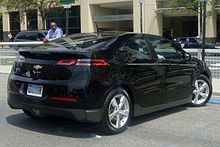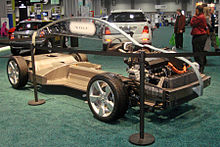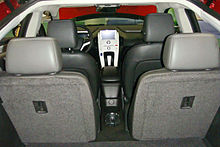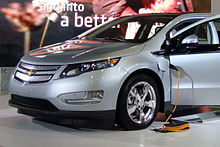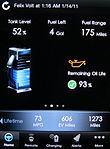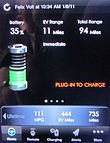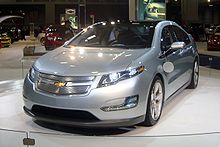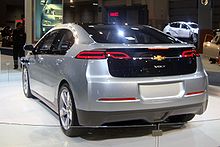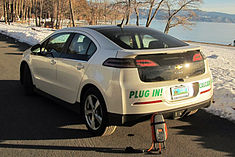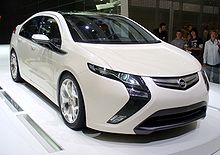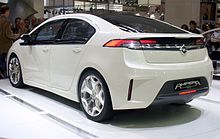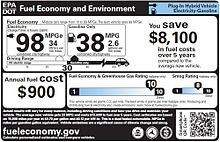- Chevrolet Volt
-
Chevrolet Volt 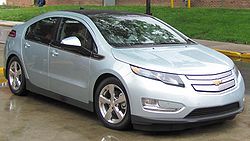
Manufacturer Chevrolet division of General Motors Also called Holden Volt
Opel Ampera
Vauxhall AmperaProduction Dec 2010–present Model years 2011-present Assembly Detroit, Michigan, United States
(Detroit/Hamtramck Assembly)Class Compact car Body style 5-door hatchback Layout Front engine, front-wheel drive Platform Delta II / Voltec Combustion engine 1.4 L 4-cylinder[1] Electric motor 111 kW (149 hp): Two 55 kW (74 hp) permanent magnet motor/generators Transmission Single gear Drivetrain 4ET50 electric drive unit[2] Battery 16 kWh lithium-ion battery Range 379 miles (610 km) (EPA) Electric Range 35 miles (56 km) (EPA)
25 to 50 miles (40 to 80 km) (GM)Wheelbase 105.7 in (2,680 mm)[1] Length 177.1 in (4,500 mm) Width 70.4 in (1,790 mm) Height 56.6 in (1,440 mm) Curb weight 3,781 lb (1,715 kg) The Chevrolet Volt is a plug-in hybrid electric vehicle manufactured by General Motors. The Volt has been on sale in the U.S. market since mid-December 2010, and is the most fuel-efficient compact car sold in the United States, as rated by the United States Environmental Protection Agency (EPA).[3][4]
According to General Motors the Volt can travel 25 to 50 miles (40 to 80 km) on its lithium-ion battery alone. The EPA official all-electric range is 35 miles (56 km), and the total range is 379 miles (610 km). The EPA rated 2011 model year Volt's combined city/highway fuel economy at 93 mpg-US (2.5 L/100 km; 112 mpg-imp) equivalent (MPG-e) in all-electric mode, and at 37 mpg-US (6.4 L/100 km; 44 mpg-imp) in gasoline-only mode, for an overall combined gasoline-electric fuel economy rating of 60 mpg-US (3.9 L/100 km; 72 mpg-imp) equivalent. The 2012 model year Volt received a revised EPA rating, increasing the combined city/highway fuel economy in all-electric mode to 94 MPG-e.[5] The Volt operates as a pure battery electric vehicle until its plug-in battery capacity is depleted; at which point its gasoline engine powers an electric generator to extend the vehicle's range. The Volt's regenerative braking also contributes to the on-board electricity generation. In order to improve performance, the internal combustion engine may at times be engaged mechanically to assist both electric motors to propel the Volt.
The suggested retail price for the 2011 Chevrolet Volt in the U.S. starts at US$40,280 before the US$7,500 U.S. federal tax credit and additional incentives are available in some locations. The 2012 Volt base price will be US$1,005 less than the 2011 model, as the base configuration has been defeatured. The 2011 Volt is being sold only in selected U.S. markets and nationwide availability of the 2012 model year is expected by November 2011. Deliveries of the 2012 Volt began in Canada in September 2011, and the suggested retail price starts at CAD 41,545 (US$43,568) before any available rebates. The initial Canadian launch is also limited to selected markets and availability in the rest of Canada is expected before the end of 2012. In the Eurozone the Volt platform will be sold as the Opel/Vauxhall Ampera, and is expected to be sold for about €42,900 (US$58,000) including VAT before any government incentives. In the United Kingdom the Vauxhall Ampera is expected to be priced at GB£33,995. Exports to Europe and China are scheduled for late 2011.
Among other awards and recognition, the Chevrolet Volt won the 2009 Green Car Vision Award, 2011 Motor Trend Car of the Year, 2011 Green Car of the Year, 2011 North American Car of the Year, and 2011 World Green Car. Despite the awards earned and the positive reception from many automotive critics, there has been some controversy and concerns in the media. These include the extent of the federal government participation in the Volt development during General Motors' 2009 government-led bankruptcy; concerns about the Volt's relatively high sales price; and complaints about price markups due to the Volt's initial limited supply.
Contents
Terminology
Further information: Hybrid vehicle drivetrainThe Society of Automotive Engineers' (SAE) definition of a hybrid vehicle states that the vehicle shall have "two or more energy storage systems both of which must provide propulsion power, either together or independently."[6] General Motors has avoided the use of the term "hybrid" when describing its Voltec designs, even after the carmaker revealed that in some cases the combustion engine provided some assist at high speeds or to improve performance.[7] Instead General Motors describes the Volt as an electric vehicle equipped with a "range extending" gasoline powered internal combustion engine (ICE) as a genset and therefore dubbed the Volt an "Extended Range Electric Vehicle" or E-REV.[8][9] In a January 2011 interview, the Chevy Volt's Global Chief Engineer, Pamela Fletcher, referred to the Volt as "an electric car with extended range."[10]
According to SAE's definition the Volt is a hybrid vehicle, due to the combination of an internal combustion engine and electric motors, and its configuration can be referred to as a plug-in hybrid.[11] The Volt operates as a purely electric vehicle for the first 25 to 50 miles (40 to 80 km), after which it functions primarily as a series hybrid, as the internal combustion engine acts primarily as a generator to power the electric traction motor. When the initial pure EV battery capacity drops below a pre-established threshold from full charge and while the Volt is operating in series hybrid mode, the Volt's control system will select the most optimally efficient drive mode to improve performance and boost high-speed efficiency. At certain loads and speeds, 30 to 70 mph (48 to 110 km/h), the internal combustion engine may at times be engaged mechanically via a clutch to an output split planetary gearset and assist the traction motor to propel the Volt. Therefore, the Volt can operate as an all-electric vehicle, a series hybrid or a parallel hybrid depending on the battery's state of charge (SOC) and operating conditions.[11][12][13] The Volt has an automotive drive system different from any existing car, but as a series hybrid or when in gasoline mode, the Volt operates similarly to conventional diesel-electric railroad locomotives, which use the combustion engine only to produce electricity to drive the electric traction motors, except for the times when the Volt needs to improve performance.[11]
History
Concept vehicle
See also: GM Voltec powertrainThe Chevrolet Volt concept car was unveiled at the January 2007 North American International Auto Show, becoming the first-ever series plug-in hybrid concept car shown by a major manufacturer.[14][15] The Volt concept vehicle had four doors with a rear liftgate and seating for four passengers. This was a significant change in design when compared to the General Motors EV1 of the 1990s, which only seated two to reduce weight and to make the necessary room for the lead-acid battery pack. The top speed was also increased on the Volt, from the electronically limited 80 miles per hour (130 km/h) to 100 miles per hour (160 km/h). The battery pack size was reduced, from about 10.6 cu ft (300 L) in volume in the EV1, to just 3.5 cu ft (100 L) in the Volt.[14][16]
Then General Motors' Vice Chairman Robert Lutz has told publicly that the two-seat sports car being developed by Tesla Motors, the Roadster, and the rapid advancement of lithium-ion battery technology inspired him to push the carmaker to develop the Volt after the 2006 Detroit Auto Show.[17][18][19] Lutz's initial idea was to develop an all-electric car, but Jon Lauckner, General Motors Vice President for Global Vehicle Development, convinced him that to avoid an expensive battery, range anxiety concerns, and lack of public charging infrastructure, they could use a smaller battery pack with a small gasoline engine driving a generator acting as a backup to extend the range, but without a mechanical connection between the gasoline engine and the drive wheels, so it would be a pure electrically driven vehicle without many of the limitations General Motors learned from the EV1 experience.[18]
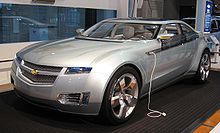 The Chevrolet Volt concept car was unveiled at the January 2007 North American International Auto Show.
The Chevrolet Volt concept car was unveiled at the January 2007 North American International Auto Show.
Most of the Volt initial design parameters defined for the development of the concept car, then referred as the "iCar" in homage to the iPod, were kept throughout the process up to the final production version. A key design parameter was a target of 40 miles (64 km) for the all-electric range, selected to keep the battery size small and lower costs, and mainly because research showed that in the U.S. 78 percent of daily commuters travel 40 miles or less. This target range would allow most travel to be accomplished electrically driven and the assumption was made that charging will take place at home overnight. This requirement translated using a lithium-ion battery pack with an energy storage capacity of 16 kWh considering that the battery would be used until the state of charge (SOC) of the battery reached 30%. This limit to the SOC was necessary in order to maintain operational performance under a wide range of environments, and to minimize the battery degradation to allow at least a ten year life span. The initial target range for the gasoline engine/generator was set between 250 to 300 miles (400 to 480 km) and the vehicle had to be family size for four or five passengers.[18][20]
Another key design decision was to develop the concept car based on a new family of common powertrain components for electric propulsion, which initially was called the E-Flex Systems, “E” stands for electric drive and “Flex” for the different sources of electricity, but later was renamed Voltec drive system. The E-Flex or Voltec platform is an attempt to standardize many components of possible future electrically propelled vehicles, and to allow multiple interchangeable electricity-generating systems. The E-Flex platform has the potential to adapt the vehicles to pure battery electric, to fuel cell-powered or to several other sources of energy to create electricity on board, such as engine-generator sets (genset) fueled by gasoline, diesel, biodiesel, ethanol fuel (E100), or flex-fuel (E85). Regenerative braking would also contribute to the on-board electricity generation.[15][21][22] On October 2006 the E-flex platform was selected for the new propulsion architecture and the name Volt was chosen by General Motors.[21]
The Volt concept car became the first application of the E-Flex (Voltec) drive system with a combination of an electric motor, the same used in the Chevrolet Equinox Fuel Cell, a 16 kWh (58 MJ) lithium-ion battery pack with 136 kW of peak power, and a genset consisting of a small 1.0 L, 3-cylinder turbocharged flex-fuel capable engine linked to a 53 kW (71 hp) generator. General Motors called this genset an electric vehicle (EV) range extender. The vehicle was propelled by an electric motor with a peak output of 120 kW (160 hp) delivering 236 lb-ft (320 N-m) of motoring torque. The concept car featured several advanced materials from GE Automotive Plastics which allowed to reduce the vehicle weight up to 50 percent.
The Volt concept featured a 12 US gal (45 l; 10.0 imp gal) fuel capacity providing the vehicle a total driving range of around 640 mi (1,030 km), which considered a gasoline fuel efficiency of about 50 mpg-US (4.7 L/100 km; 60 mpg-imp) and a 40 mi (64 km) all-electric range. According to General Motors estimates, a daily drive of 60 mi (97 km), combined with an overnight recharge to support the first 40 all-electric miles, would yield an effective gasoline fuel economy of 150 mpg-US (1.6 L/100 km; 180 mpg-imp).[15][22] General Motors also emphasized that the Volt would further reduce dependence on imported oil if E85 ethanol was used instead of gasoline to power the on-board generator engine. Robert Lutz added that if the driver used E85, "the fuel economy figure became 525 miles per (equivalent) petroleum gallon", as only 15% of gasoline is used in this blend.[23][24] General Motors also noted that actual production of the Volt depended on further battery development, because the required rechargeable batteries needed to make the Volt a viable vehicle did not exist in the market and had yet to be developed.[15][18][24] The concept car was actually powered by two 12-volt conventional car batteries, just enough power to allow the vehicle to move at low speeds in the stand.[25]
Production model
The production design model officially unveiled on September 16, 2008, as part of General Motors centennial celebration at the Wintergarden headquarters in Detroit. The production model differed greatly in design from the original concept car. The carmaker cited necessary aerodynamic changes needed to extend the Volt's initial full-charge range by reducing the concept cars's drag coefficient (Cd).[26][27] Another reason was to use of General Motors' new Delta II platform to keep costs reasonable. The global compact vehicle architecture chosen is shared by the planned 2010 Chevrolet Cruze and the 2012 Saab 9-3.[28] Another significant difference with the concept car is the seating, as the production Volt seats four rather than five passengers. This change was due the higher-than-usual central tunnel that runs from the front console to the rear seat. This tunnel houses the car's T-shaped battery pack.[29]
General Motors found that due to its angular shape, the Volt's concept car had a high drag coefficient of 0.43, "roughly the same aerodynamic efficiency as a Chevrolet Silverado pickup", which would put a burden on the electric range, and as a result General Motors' designers and engineers spent more than 1,000 hours in the wind tunnel reworking the exterior shape of the Volt.[30] According to General Motors engineers, the Volt's drag coefficient is the carmaker's second best only to the GM EV1 (Cd=0.19 ).[30] General Motors initially claimed that the production model's drag coefficient would be lower than the Toyota Prius (Cd=0.25), but the production vehicle has a drag coefficient of 0.29.[31][32]
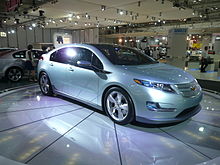 First production version of the Chevrolet Volt at the 2008 Australian International Motor Show
First production version of the Chevrolet Volt at the 2008 Australian International Motor Show
After the concept was put into the pipeline for production, General Motors began looking for a partner to develop the Volt's lithium-ion battery pack. The carmaker evaluated about twenty-five different battery cell chemistries and constructions from around two dozen lithium-ion battery makers around the world.[33] Due to their more promising cell technologies, two companies were selected in June 2007, Compact Power (CPI), which uses a lithium manganese oxide (LiMn2O4) cell made by its parent company, LG Chemical; and Continental Automotive Systems, which uses lithium iron phosphate based cylindrical cells made by A123Systems.[33][34][35] By the end of October 2007 CPI (LG Chem) delivered their finished battery pack prototypes, and A123 delivered theirs by January 2008. General Motors testing process was conducted at the laboratory the carmaker had created for the GM EV1 program, and would lead to chose one of the suppliers. The battery packs included monitoring systems designed to keep the batteries cool and operating at optimum capacity despite a wide range of ambient temperatures.[33][35] In order to make sure the battery pack would last ten years and 150,000 miles (240,000 km) expected for the battery warranty, the Volt team decided to use only half of the 16 kW·h capacity to reduce the rate of capacity degradation, limiting the state of charge (SOC) up to 80% of capacity and never depleting the battery below 30%.[35][36] General Motors also was expecting the battery could withstand 5,000 full discharges without losing more than 10% of its charge capacity.[35]
In April 2008 General Motors started extensive battery testing. In two years the carmaker put the battery packs to the equivalent of 150,000 real-world miles (240,000 km) and ten years of use.[35] The durability of the battery pack was tested for a broad range of extreme ambient conditions including a shaker table to simulate potholes and a thermal chamber, to simulate temperatures varying from 116 °F (47 °C), typical of the Southwest deserts, to −40 °F (−40 °C) typical of the Alaska tundra.[30][33] In April 2008 the lithium-ion battery pack was placed in Chevrolet Malibus fitted with the Volt powertrain to be used as test mules for further real-world testing.[35][37] In October 2008 General Motors chose CPI (LG Chemical) to provide the battery systems for the first production version of the Volt.[38][39] In July 2008 General Motors confirmed that a non-turbocharged, 1.4 liter 4-cylinder engine would be used as the range extender, and that the intention was to build it in Flint, Michigan.[40]
In April 2009, General Motors allowed journalists to test the Volt powertrain in the body of Chevrolet Cruze sedans used as test mules which lacked the range-extending generator. The driving tests were conducted at GM Technical Center in Warren, Michigan. Several of the journalists noted that the Volt mule's drive in electric mode is quiet and smooth, without any of the typical noises in commercially available hybrids when accelerating or decelerating. In November 2009, a journalist described the 'feel' of driving the car as it transitioned from electric to generator mode as "the engine’s initial engagement is inaudible and seamless"[41]
The first pre-production test car based on the final Volt design was built in June 2009, in Warren, Michigan,[42][43] and by October 2009, 80 Volts had been built and were tested under various conditions.[43][44] On March 31, 2010, the first factory-built Volt was produced at the Detroit Hamtramck Assembly Plant in order to test the production line and for quality control purposes, both of the tooling and the pre-production vehicles produced before regular production began.[45][46]
- Official introduction
General Motors held a ceremony at its Detroit/Hamtramck Assembly plant on November 30, 2010, to introduce the first Chevrolet Volt off the assembly line. The first Volt built for retail sale was earmarked for display at General Motors' Heritage Center museum in Sterling Heights, Michigan.[47][48] The second unit was offered at a public auction, with an opening bid of US$50,000 and it was won by Rick Hendrick who paid US$225,000. The proceeds went to fund math and sciences education in Detroit through the Detroit Public Schools Foundation.[49] Sales and deliveries began in mid December 2010 and the first retail vehicle was delivered to a customer in Denville, New Jersey on December 15, 2010.[50]
Specifications
Drivetrain
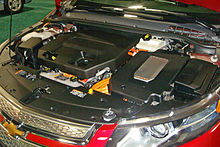 Right side: the power inverter on top of the electric drive unit (electric motor) used for traction; left side: the 1.4-liter gasoline-powered engine used as a generator to provide power to the electric motor or to engage mechanically to assist propulsion when the battery is depleted
Right side: the power inverter on top of the electric drive unit (electric motor) used for traction; left side: the 1.4-liter gasoline-powered engine used as a generator to provide power to the electric motor or to engage mechanically to assist propulsion when the battery is depleted
The 2011 Chevrolet Volt has a 16 kW·h / 45 A·h (10.4 kW·h usable) lithium-ion battery pack that can be charged by plugging the car into a 120-240 VAC residential electrical outlet using the provided SAE J1772-compliant charging cord. No external charging station is required.[51] The Volt is propelled by an electric motor with a peak output of 111 kW (149 hp) delivering 273 lb-ft (368 N-m) of torque. After the Volt battery has dropped to a predetermined threshold from full charge, a small naturally aspirated 1.4-liter 4-cylinder internal combustion engine (Opel's Family 0) with approximately 80 horsepower, burns premium gasoline to power a 55 kW (74 hp) generator to extend the Volt's range. Additionally, under certain conditions, when performance needs to be improved the gasoline engine can also engage the powertrain mechanically to assist propulsion directly, resulting in a slight efficiency boost. The vehicle also has a regenerative braking system. The electrical power from the generator is sent primarily to the electric motor, with the excess going to the batteries, depending on the state of charge (SOC) of the battery pack and the power demanded at the wheels.[1][52]
The Volt requires premium gasoline because the higher octane rating fuel allows the 10.5:1 compression ratio engine to maximize its fuel efficiency by 5 to 10% as compared to regular gasoline.[53][54] For users who drive mostly in electric mode and to avoid maintenance problems caused by storing the same gasoline in the tank for months, the 2011 Volt has a sealed and pressurized fuel tank to avoid evaporation, and as a result, the fuel filler has to be depressurized before opening the tank. Also the engine management system monitors the time between engine running and it is programmed to prompt the driver to run past the 40-mile (64 km) all-electric range before recharging in order to consume some gasoline. If the driver does not run on gasoline, the system will automatically run the maintenance mode which starts the engine to consume some of the aging fuel and circulate the fluids within the engine.[55] A configuration with an E85 flex-fuel capable engine is under development and is expected to be available in 2013.[11]
Powertrain cut-away of the Volt showing both engines and the underfloor T shape tunnel where the battery pack is locatedThe Voltec drivetrain platform permits the Volt to operate as a pure battery electric vehicle until its plug-in battery capacity has been depleted at a predetermined level, at which time it commences to operate as a series hybrid design since mechanical power drives the generator, which in turn either charges the battery pack or provides power to the electric motors. While in this series mode at higher speeds and loads, (typically above 30 miles per hour (48 km/h) and/or under hard acceleration) the gasoline engine can engage mechanically to the output from the transmission and assist both electric motors to drive the wheels, hence the Volt can also operate as a power-split or series-parallel hybrid when additional power is required. After its all-electric range has been depleted, at speeds in between 30 to 70 miles per hour (48 to 110 km/h), the Volt is programmed to select the most efficient drive mode of the two, a design feature that allows the Volt to improve performance and boost high-speed efficiency by 10 to 15 percent.[11][13]
The 2011 Volt has three drive modes, normal, sport and mountain. The mountain mode, which is expected to be required only under unusual power demand conditions, increases minimum battery state of charge (SOC) to around 45%, helping the Volt to maintain performance on steep and long grades. The driver will hear more engine noise when operation in mountain mode due to the higher rate of power generation required to maintain this mode.[13] The sport mode causes the engine to rev higher and the response to the "throttle" pedal is quicker.[56]
Battery
See also: Electric vehicle batteryThe Volt's lithium-ion battery (Li-ion) battery pack weighs 435 lb (197 kg) and consists of 288 individual cells arranged into nine modules. Plastic frames hold pairs of lithium-ion cells that sandwich an aluminum cooling fin. The design and construction of that aluminum plate was critical to ensuring an even temperature distribution with no hot or cool spots across the flat, rectangular cell. The battery pack has its own cooling circuit that is similar to, but independent from, the engine cooling system.[52][57]
The battery pack stores 16 kW·h of energy but it is controlled or buffered via the energy management system to use only 10.4 kW·h of this capacity to maximize the life of the pack. For this reason the battery pack never fully charges or depletes, as the software only allows the battery to operate within a state of charge (SOC) window of 65%, after which the engine kicks in and maintains the charge near the lower level. The minimum SOC varies depending on operating conditions. When more power is required, such as mountain mode, the lower limit of the SOC will raise to 45% to ensure there is enough power available.[13][52]
Despite containing near identical energy (+/- 0.5kWh), the Volt's battery pack is over 70% lighter than the EV1's original 1,310 lb (590 kg), 16.5 kW·h AC Delco lead-acid battery pack, mainly because the Volt uses higher specific energy Li-ion batteries. Li-Ion batteries are expected to become less expensive as economies of scale take effect.[58][59][60]
Because batteries are sensitive to temperature changes, the Volt has a thermal management system to monitor and maintain the battery pack temperature for optimum performance and durability. The Volt's battery pack provides reliable operation, when plugged in, at temperatures as low as −13 °F (−25 °C) and as high as 122 °F (50 °C). Because the Volt features a battery pack that can be warmed or cooled, in cold weather the battery is preheated during charging to provide full power capability; in hot weather the battery can be cooled during charging. The Volt’s thermal management system can also be powered during driving either by the battery or engine.[52][61]
The Volt's battery is guaranteed by General Motors for eight years or 100,000 miles (160,000 km), and will cover all 161 battery components.[61][62] As all rechargeable batteries degrade over time, General Motors estimates the Volt battery will degrade by 10 to 30% after 8 to 10 years.[63] The Volt’s battery management system runs more than 500 diagnostics at 10 times per second, allowing to keep track of the Volt’s battery pack in real-time, 85% of which ensure the battery pack is operating safely and 15% monitor battery performance and life.[61]
The Volt uses a new plug specification, SAE J1772-2009, that is being proposed as a standard for electric cars.[51] A full charge takes approximately ten to twelve hours from a standard North American 120V, 15 A household outlet and about three hours from a standard 240 VAC outlet. The Volt comes with a 20 ft (6.1 m) 120V charging cord. If plugged in, recharging can be controlled remotely through a smartphone application.[52]
Performance
The Volt has a top speed of 100 mph (160 km/h).[11] According to Edmunds.com road tests, the Volt's 0 to 60 mph (0–97 km/h) acceleration time is 9.2 seconds running on electric-only mode, and 9.0 seconds with the gasoline engine assisting propulsion.[64] Motor Trend reports the Volt's quarter mile (402 m) time is 16.9 sec @ 84.3 mph (135.7 km/h),[65] while Edmunds reports a quarter mile (402 m) time of 16.8 sec @ 81.5 mph (131.2 km/h) in electric-only operation, and 16.6 sec @ 85.5 mph (137.6 km/h) with the gasoline engine assisting.[64] Motor Trend reports a 60 to 0 mph (97 to 0 km/h) braking distance of 112 ft (34 m) and Edmunds.com of 124 ft (38 m).[64][65]
Range
- United States
According to General Motors the Volt's all-electric range with fully charged batteries varies from 25 to 50 miles (40 to 80 km) depending on terrain, driving technique, temperature.[11][66] The Environmental Protection Agency (EPA) official all-electric range is 35 miles (56 km) with an energy consumption of 36 kWh per 100 miles (810 kJ/km). This range is based on the agency's five-cycle tests using varying driving conditions and climate controls. The total range with a full tank of gasoline and a fully charged battery is 379 miles (610 km) according to EPA tests.[67][68]
The Volt's fuel tank capacity is 9.3 US gallons (35 l; 7.7 imp gal) and once the car runs out of fuel, the gasoline-powered generator shuts down, and the Volt taps into the battery for extra power. The reserve battery power is designed to provide an extra 3 to 4 mi (4.8 to 6.4 km) of range once the gasoline tank is depleted. When the reserve battery power is low, the Volt safely slows to a stop.[69]
- Europe
The Opel Ampera official all-electric range under the EU-approved UN ECE R101 standard for plug-in hybrids is 83 km (52 mi). Opel prefers to state that the Ampera's EV ranges is 40 to 80 kilometres (25 to 50 mi).[70]
Fuel economy
- United States
The U.S. Environmental Protection Agency (EPA) officially rated the 2011 model year Volt's combined city/highway fuel economy in all-electric mode at 93 miles per gallon gasoline equivalent (MPG-e) (2.5 L gasoline equivalent/100 km; 112 mpg-imp gasoline equivalent). This rating considers a conversion factor of 33.7 kW-hr of electricity being the energy equivalent of a gallon of gasoline. The EPA rating in gasoline-only mode is 37 mpg-US (6.4 L/100 km; 44 mpg-imp). The overall combined city/highway gasoline-electricity fuel economy rating is 60 mpg-US (3.9 L/100 km; 72 mpg-imp) equivalent (MPG-e),[67][71] making the Volt the most fuel-efficient compact car sold in the United States since its introduction in December 2010.[3][4][72] For the 2012 model year, EPA revised the Volt's fuel economy ratings, increasing the combined city/highway rating in all-electric mode from 93 MPG-e to 94 MPG-e, and the highway rating was increased from 90 MPG-e to 93 MPG-e.[5]
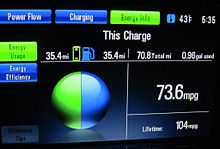 The Volt digital panels keep track of energy usage by fuel source and average fuel economy.
The Volt digital panels keep track of energy usage by fuel source and average fuel economy.
The EPA also included in the Volt's fuel economy label a table showing fuel economy and electricity consumed for five different scenarios: 30, 45, 60 and 75 miles (121 km) driven between a full charge, and a never charge scenario. This information was included in order to make the consumers aware of the variability of the fuel economy outcome depending on miles driven between charges. Under the gasoline-only scenario (never charge), the 37 mpg-US (6.4 L/100 km; 44 mpg-imp) figure results from 35 mpg-US (6.7 L/100 km; 42 mpg-imp) city driving and 40 mpg-US (5.9 L/100 km; 48 mpg-imp) on the highway.[67]
In April 2011 General Motors reported, based on data collected through its OnStar telematics system since Volt deliveries began in December 2010, that Volt owners drive in average 800 miles (1,300 km) before they need to fill up the gasoline tank. The analysis also found that the average period between fill-ups is 30 days.[73] In November 2011 General Motors reported that with more than 10 million cumulative miles driven by Volt owners, their data shows that around two-thirds of miles driven were in electric mode.[74]
- Europe
The Opel Ampera official equivalent fuel consumption under the EU-approved UN ECE R101 standard for plug-in hybrids is 1.2 L/100 km (196.0 mpg-US) (83 km/l).[75] However, a leading Opel engineer prefers saying 169 Wh/km while battery-powered, and then 20km/l petrol-powered. The ECE R101 standard weights charge-depleting mode as 76% and gasoline-only driving as 24%.[70]
Tailpipe emissions
- United States
EPA rating for the Volt's tailpipe emissions is 84 grams of carbon dioxide per mile, (52.5 CO2 g/km),[72][76] which puts the Volt ahead of the Toyota Prius in terms of low greenhouse emissions as measured at the tailpipe. CO2 emissions are produced by the internal combustion engine in extended-range mode, and only after the Volt's primary battery charge has been depleted. In the other air pollutants category, the Volt rates six out of ten, with ten being best.[76]
The California Air Resources Board (CARB) classified the Volt as Ultra Low Emission Vehicle (ULEV), as CARB tests do not account for the Volt electric range. With all tests conducted under conditions where the engine is running the CARB rated the Volt's carbon monoxide (CO) emissions at 1.3 g/mile (0.81 g/km), missing the limit for SULEV classification by 0.3 g/mile (0.19 g/km).[77]
- Europe
The Ampera's official EU-approved UN ECE R101 carbon dioxide emission rating is 27g/km.[75]
Safety
The 2011 Chevrolet Volt standard features include 4-wheel anti-lock brakes with traction control; StabiliTrak electronic stability control system with brake assist; tire-pressure monitoring system; and 8 total airbags: dual-stage frontal, side-impact and knee for driver and front passenger, and roof-rail side-impact for front and rear outboard seating positions, with a passenger sensing system. There is also available an optional emergency assistance system.[1][64]
The 2011 Chevrolet Volt was named "Top Safety Pick" by the Insurance Institute for Highway Safety. The Volt received the top ratings of "Good" for front, side, and rear impact crash tests, and also on rollover protection. All injury measurements except one were rated good, indicating a low risk of significant injuries in crashes according to the scale of severity employed in the IIHS’s testing. The Volt's lower rating of "Acceptable" was for torso injuries.[78]
The Volt received a five-star overall crash safety rating from the National Highway Traffic Safety Administration (NHTSA), the highest-possible score. This rating was obtained with NHTSA's New Car Assessment Program which is used for 2011 model year vehicles.[79]
- Accident and rescue handling
In August 2010, General Motors began a training program for first responders when performing rescue duties involving the Chevrolet Volt. The program began at the 2010 Fire-Rescue International in Chicago, using a pre-production Volt for a live extrication exercise. Chicago firefighters demonstrated the sequence of tasks required to safely disable the vehicle’s powertrain and its 12 volt electrical system, which controls its high-voltage components, and then proceed to extricate injured occupants.[80] As of January 2011, additional training workshops had took place in Detroit, Los Angeles, San Francisco, Austin, Texas, Washington, D.C. and New York City, corresponding to the Volt's initial launch markets.[81] An Emergency Response Guide for the 2011 Volt was made available at its Service Technical College for use by emergency responders. The guide also describes methods of disabling the high voltage system and identifies cut zone information.[82]
GM recommends that a Volt battery fire be fought with water rather that dry chemicals, and rates the Volt battery as having no explosion or electrocution hazard as the result of a collision. The high-voltage system is designed to shut down automatically in the event of an airbag deployment, and to detect a loss of communication from an airbag control module. During the Volt development the lithium-ion battery pack was subjected to a wide range of tests, including overcharge, discharge, vibration, excess heat and cold, short circuit, humidity, fire, crush, water immersion, salt water immersion, and nail penetration.[80]
- Warning sounds
Further information: Electric vehicle warning soundsDue to significant noise reduction typical of hybrids and plug-ins vehicles traveling in all-electric mode at low speeds, General Motors equipped the Volt with an electronic warning sound system for optional use when the car is operating at low speeds to alert the blind and other pedestrians to the car's presence. General Motors system is called Pedestrian-Friendly Alert System and is manually activated by the driver.[83] Based on the U.S. Pedestrian Safety Enhancement Act of 2010, signed into law in January 2011, the U.S. Department of Transportation is performing studies to establish a U.S. vehicle safety standard that would set requirements for the alert sound, and the ruling is expected to be finalized before mid 2012.[84]
- Fire incidents
In June 2011 a Volt that had been subjected to a 20 mph side-impact crash test by the National Highway Traffic Safety Administration ( NHTSA) caught fire three weeks later in the test center parking lot, burning nearby vehicles. The battery was found to be the source of the fire. After the fire, both Chevrolet and the NHTSA independently replicated the crash test and a subsequent vehicle rotation procedure to test for any fluid leakage, but they could not reproduce the conditions under which the battery pack ignited. The NHTSA said it had "concluded that the crash test damaged the Volt’s lithium-ion battery and that the damage led to a vehicle fire that took several weeks to develop." Regarding this incident, the NHTSA issued an statement saying that "Based on the available data, NHTSA does not believe the Volt or other electric vehicles are at a greater risk of fire than gasoline-powered vehicles. In fact, all vehicles – both electric and gasoline-powered – have some risk of fire in the event of a serious crash." [85][86]
The agency announced in November 2011 that they were examining lithium-ion batteries used in electric cars and also that they are planning to work with the Energy Department to conduct additional testing in the next few weeks. The NHTSA also said it was working with all automakers to develop postcrash procedures to keep occupants of electric vehicles and emergency personnel who respond to crash scenes safe. General Motors said the fire would have been avoided if GM's protocols for deactivating the battery after the crash had been followed. In another statement the carmaker stated that they "are working with other vehicle manufacturers, first responders, tow truck operators, and salvage associations with the goal of implementing industrywide protocols."[86][87]
During 2011 two other Volts were involved in garage fires, one in Barkhamsted, Connecticut, in April 2011, and another in Mooresville, North Carolina, in November 2011. In the Connecticut case, the fire marshal's report concluded the Volt that was parked in the garage had nothing to do with the cause of the fire. In the Mooresville case, a Volt was charging in the garage at the time of the fire and fire officials have not found yet the origin of the fire.[88] NHTSA sent a team of investigators to Mooresville to participate in the investigation.[85]
Other features
Smartphone display of total and EV range- Connectivity
The Volt features OnStar Mobile application for owners to access vehicle information without being in or near the car. This smartphone application features the ability to check fuel efficiency as well as the vehicle's current electric range. It also helps monitor the charging, giving owners key information about the current charge level and the amount of time it will take until it is fully charged. The application also is able to control features such as locking/unlocking doors, and acts as a remote starter.[89] A five year OnStar service is bundled into the Volt's US$41,000 base price.[90]
- 2011 model year
The 2011 Chevrolet Volt comes standard with cruise control; remote vehicle start-up system; 17-inch 5-spoke forged painted aluminum wheels; Bluetooth wireless technology for select phones; audio and navigation system with a center console capacitive touch panel and DVD and MP3 playback, with voice recognition; OnStar with five years of service; BOSE premium speaker system, with six speakers and sub-woofer; 30 GB hard drive for audio data storage; USB ports; three auxiliary, 12-volt, power outlets; power door locks and windows; power adjustable mirrors; premium cloth seating; programmable time of day charge control; and a 110-volt charge cord.[1]
Available options include three different colors of premium paint; 17-inch 5-spoke forged polished-aluminum wheels; door trim premium with layered graphics; rearview camera system, rear camera and parking assist package, and ultrasonic parking assist, front and rear; leather-wrapped steering wheel; and heated leather front seats with selectable automatic activation.[1][91]
- 2012 model year
General Motors announced that the 2012 Volt standard features will include a passive remote keyless access with passive locking allowing the car to automatically lock and unlock with the key fob in close proximity of vehicle; OnStar turn-by-turn navigation for three years, and available in-dash navigation system; and Chevrolet MyLink including Bluetooth streaming audio for music and select phones. The 2012 Volt will be available in two additional interior accents: white and spiced red; and two new exterior colors: summit white and blue topaz metallic.[92][93]
The 2012 Volt will have a total of seven option packages while the 2011 model had only three. Among other options the 2012 model includes leather seats, a backup camera, navigation system, and premium paint. Also 17-inch sport alloy wheels with black inserts will be available later.[92][93]
Production and sales
North America
Assembly of the Volt was assigned to Detroit/Hamtramck Assembly plant following the conclusion of the 2007 UAW-GM contract talks.[94] For initial production the gasoline engine is being imported from the Opel engine plant in Aspern, Austria.[95] In November 2010, General Motors began investing US$138.3 million at its engine operations plant in Flint, Michigan to support increased production of the Ecotec 1.4-liter engine that is used in the Chevrolet Cruze, the upcoming 2012 Chevrolet Sonic, and the variant used in the Chevrolet Volt. The Flint plant was expected to start production of 400 engines a day in early 2011, ramp up daily production to 800 engines in late 2011, and to increase its capacity to 1,200 a day by late 2012.[96] In May 2011, General Motors decided to invest an additional US$84 million at the Flint plant to further increase 1.4-liter engine production capacity.[97]
In 2010, General Motors planned an initial production for calendar year 2011 of 10,000 Volts and 45,000 units for 2012, up from the 30,000 units initially announced.[98] In May 2011, the carmaker again raised its production targets. By mid June production was halted for about one month at the Detroit/Hamtramck Assembly plant to complete some upgrades, including the installation of new tooling, equipment and overhead conveyor systems throughout the facility. These upgrades allowed to triple the rate of Volt production and prepared the plant for 2012 Volt and Ampera production. As a result, Volt and Ampera production capacity will increase to 16,000 units in 2011, including 3,500 units for exports and 2,500 demonstration units destined to U.S. dealerships, and the rest for U.S. sales. In 2012, global production capacity is expected to be 60,000 vehicles with an estimated 45,000 units to be delivered in the United States.[99][100][101] Out of the 2012 production, General Motors will produce 10,000 Amperas available for sale in Europe, 6,000 destined for Opel and 4,000 for Vauxhall in the UK. In addition, 2,000 Volts will be made available for the region.[102]
The Volt's battery cells are produced by LG Chem in South Korea and subsequently shipped to the US, where the battery packs are assembled at a purpose-built facility in Brownstown Township, Michigan owned and operated by General Motors.[103] Compact Power, the North American subsidiary of LG Chem, is building a battery plant in Holland, Michigan to manufacture the advanced battery cells for the Volt and other carmakers, with capacity to produce enough cells for 50,000 to 200,000 battery packs per year.[104] The US$303 million Holland plant was funded by 50% U.S. Department of Energy matching stimulus funds and is planned to open by mid 2012.[105]
The 2011 Chevrolet Volt was officially launched on November 30, 2010 at a ceremony at the Hamtramck plant, where the first production unit for retail sale came off the assembly line.[47][48] The first retail vehicle was delivered to a customer in Denville, New Jersey on December 15, 2010.[50]
United States
The 2011 Chevrolet Volt is being sold only in selected markets due to limited initial production, as General Motors original target for 2011 was only 10,000 units.[106] The first cars were delivered in Washington D.C., the New York City metropolitan region, California, and Austin, Texas.[107] As of May 2011, the Volt had been launched also in Connecticut, Maryland, Michigan, New Jersey, and Virginia.[99] Deliveries in Delaware, Florida, Georgia, Hawaii, North Carolina, Oregon, Pennsylvania, South Carolina, and Washington are expected for the third quarter of 2011.[108] In June 2011, Chevrolet dealers nationwide began taking orders for the 2012 Volt, and deliveries in all 50 states are expected by November 2011.[92][93]
The suggested retail price (MSRP) for the 2011 Chevrolet Volt in the U.S. starts at US$40,280 which excludes destination freight charge, tax, title, license, dealer fees and optional equipment and before any savings due to factory incentives, tax deductions, or other available subsidies for qualifying buyers.[90][109] The MSRP for the 2012 Volt will start at US$39,995 including a US$850 destination freight charge and excludes tax, title and license fees, or other available government subsidies. The base price is US$1,005 less than the 2011 model year, and General Motors explained that this price reduction is possible because of a "wider range of options and configurations that come with the expansion of Volt production for sale nationally."[92][93]
Due to the capacity of the Volt's battery pack it qualifies for the maximum US$7,500 federal tax credit as specified in the Emergency Economic Stabilization Act of 2008.[110] The federal tax credit phases out over a one year period after the manufacturer has sold at least 200,000 vehicles in the U.S.[111] Several states also have additional incentives or rebates available for plug-in electric vehicles for qualifying buyers.[90][112] The 2011 Volt price including all available regular production and premium options is US$44,600, including destination charges and before tax credits or any subsidies.[91] For the 2012 model year the price of the Volt with all available options is US$46,265 before tax credits or any subsidies available.[92][93]
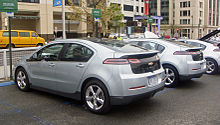 Production Volts at a test drive event in Washington, D.C.
Production Volts at a test drive event in Washington, D.C.
The 2011 Chevrolet Volt is also available through leasing with a monthly payment of US$350 for 36 months, with US$2,500 due at lease signing, and with an option to buy at the end of the lease.[90][113] Although the Volt's retail price is higher than its main competitor, the 2011 Nissan Leaf, the lease rate for the Volt is almost the same as its competitor, except that the Leaf has a lower initial payment. General Motors explained that "the apparent disparity between the Volt's sticker and lease prices is a reflection of the company's calculation that the vehicle will maintain a very high residual value after three years—significantly higher than that of the LEAF."[113][114]
The price for the home charging units is US$490 plus installation costs. The Voltec home-charging unit is a 240-volt (Level II) charger, and, according to General Motors, can replenish the Volt's batteries in about four hours. Consumer Reports has advised buyers to budget up to US$2,000, as many older homes may need a substantial electrical upgrade because the U.S National Electrical Code requires that the charger have its own dedicated 220-volt, 30-amp circuit.[115] Early buyers can benefit from the federal tax credit available for charging equipment.[116]
The 2011 Volt was not submitted for application to the California Air Resources Board's (CARB) Clean Vehicle Rebate Project rebate and therefore was not required to meet the 10-year 150,000-mile (240,000 km) battery warranty requirement for enhanced advanced technology partial zero-emissions vehicles (enhAT-PZEV). The Volt team explained that for the launch General Motors decided to go with a common national package which includes an 8-year 100,000-mile (160,000 km) battery warranty.[90][117] For this reason owners of the 2011 Volt did not qualified for California's rebate's and free access to use carpool lanes even when traveling solo.[118] A third package, scheduled for 2013, is under development with an E85 flex-fuel engine.[11][90] General Motors engineering team commented that "introducing two or three packages of an entirely new technology set and platform at the same time wasn't an option."[90]
In November 2011 General Motors announced that begining in early 2012, all models sold in California will feature a new low emissions package that will allow the 2012 Chevrolet Volt to qualify as an enhanced, advanced technology –partial zero emissions vehicle (enhAT-PZEV) and have access to California’s high-occupancy vehicle lanes (HOV). The new standard California version of the Volt features a modified engine and exhaust components. The catalytic converter was modified to add a secondary air-injection pump that "streams ambient air into the exhaust stream to increase its ability to remove pollutants." Owners of a 2012 Volt with the low emissions package will be eligible to apply for one of 40,000 available HOV lane stickers issued to vehicles that qualify as a California AT-PZEV. The permits are handed out on a first-apply, first-served basis. Additionally, the new low emissions package makes the 2012 Volt eligible for owners to receive up to US$1,500 in state rebates through the state’s Clean Vehicle Rebate Project (CVRP). This incentive is in addition to the federal government’s US$7,500 tax credit.[74][119]
- Monthly U.S. sales
Since deliveries began in December 2010, General Motors has sold 5,329 Volts through October 2011.[120][121] As of October 2011 GM has also produced and delivered an additional 2,300 Volts dedicated as demonstration vehicles for customer test drives at Chevrolet dealerships.[122] Due to a one-month halt in production that took place between June and July 2011 to upgrade the Detroit/Hamtramck Assembly plant, supplied was limited during this period.[101] After the plant retooling, the production rate reached 150 units per day four days a week by August 2011.[123] By early November 2011, General Motors authorized its Chevrolet dealears to sell their Volt demos which together with 1,800 units in transit to dealers make up an inventory of 4,100 vehicles available for sales.[122][124] The following table present monthy sales since the Volt's deliveries began in December 2010. Demonstration vehicles allocated to dealerships are not included in retail sales reports while they are used for test drives.
Chevrolet Volt monthly U.S. sales (2010–2011) 2011 Jan Feb Mar Apr May Jun Jul Aug Sep Oct Nov Dec CYTD 321[125] 281[126] 608[127] 493[128] 481[129] 561[130] 125[131] 302[132] 723[133] 1,108[121] 5,003 2010 Jan Feb Mar Apr May Jun Jul Aug Sep Oct Nov Dec Total 326 326[134] - Resale value
In May 2011 Kelley Blue Book (KBB) projected the 2011 Chevrolet Volt resale value at just over US$17,000 after 36 months, the length of a typical lease, which represents 42% of the car's US$41,000 suggested retail price (MSRP). KBB explains that even though the residual value seems low, the projection considers that the first 200,000 Volts sold will qualify for a US$7,500 federal tax credit, which effectively reduces the MSRP to US$33,500, making the US$17,000 represent 51% of its original value after the tax credit. In comparison, KBB notes, the 2011 Toyota Prius has a projected residual of 46% after 36 months. KBB's estimate assumed gasoline price will be around US$4 per gallon in 2014.[135][136]
Consumer Reports commented that their own analysis show that many Chevrolets lose about half of their purchase price after three years of ownership, and if the Volt depreciates the same, US$17,000 seems a reasonable estimate. However, Consumer Reports have noted that fuel-efficient hybrids and diesel models often depreciate far less than most vehicles, which might increase the Volt's resale value after three years above the US$17,000 estimate. Additionally, if gasoline prices continue to rise or if the tax credits expire, the demand for used Chevrolet Volts could quickly increase, raising their market value. On the other hand, if the next-generation Volt’s battery has twice the capacity and cost less, as General Motors has claimed, the first generation Volts will be obsolete when the new ones come out in 2015. Considering these assumptions, Consumer Reports considers that "at this point we believe it’s still unclear how the Volt will fare."[136]
According to Kelly Blue Book the 2012 Volt is expected to retain 42% of its original value after 3 years and 27% after 5 years. Based on this figures, in November 2011 KBB awarded the Volt with the 2012 Best Resale Value Awards in the plug-in electric car category.[137][138] KBB explains that the residual value for the Volt is lower than the market 35.5% average due to the US$7,500 federal tax credit, which lowers the transction price and pushes down the residual value.[138]
Canada
Volt deliveries in Canada began in September 2011, and the initial launch markets for retail customers include Montreal, Quebec City, Toronto, Oshawa, Ottawa-Gatineau, Vancouver and Victoria.[139][140] Availability in the rest of the country is expected before the end of 2012. General Motors began taking orders in May 2011.[108][141]
The suggested retail price (MSRP) for the 2012 Chevrolet Volt starts at CAD 41,545 (US$42,423 in June 2011) which excludes any charges, fees, and optional equipment. This price is before any available subsidies or incentives for qualifying buyers. In the Canadian market, the Volt will be offered in one standard trim level with two option packages, a Premium Trim Package and a Rear Camera and Park Assist Package.[108] The Volt is being endorsed by the Ontario government and the province will provide a CAD 8,500 (US$8,680 in June 2011) tax credit for buyers.[142][143] The province also will purchase 500 Volts for the Ontario public service fleet.[144] The Quebec government will also offer rebates of up to CAD 8,500 beginning on January 1, 2012.[145] Commencing on December 1, 2011, the Government of British Columbia has announced their new LiveSmart BC program in which the Chevrolet Volt qualifies for a CAD 5,000 incentive/rebate as well as CAD 500 towards charging equipment.[146] [147]
Europe
The European version of the Volt, the Opel Ampera, was unveiled at the Geneva Auto Show in March 2009[148] and also was exhibited at the 2009 Frankfurt Auto Show.[149] General Motors will offer in the European market the choice of the Volt or the Opel/Vauxhall Ampera, the European version of the same car.[150] Opel is developing the battery control modules for the Ampera at the Opel Alternative Propulsion Center Europe in Mainz-Kastel, Germany.[151] The production version of the Ampera was unveiled at the 2011 Geneva Motor Show.[152]
The main differences between the Volt and the Ampera are in their styling. The Ampera has a distinctive front and rear fascia, with a large cut-out in the rear bumper. The Opel Ampera features more stylized alloy wheels as standard, and the side skirts are body-colored rather than black plastic. In the inside there are only minor differences and both versions share the same exact powertrain and battery pack.[153][154] A key operational difference is that the Ampera will have four drive modes, one more than the Volt. The additional option is "City Mode", which adapts battery management to the needs of commuter travel. City mode or "battery hold" engages the range-extender immediately, allowing to save the energy currently stored in the battery, and when switched off, the range-extender stops and the Ampera is then able to use the energy saved in the battery for pure electric driving, for example for traveling urban areas or restricted zones, such as the European low emission zones or to allow the Ampera to qualify for an exemption of the London congestion charge.[152][153][155]
The Opel Ampera will benefit from several subsidies and tax breaks available for plug-in electric vehicles in several European countries.[156][157] According to Opel, as of June 2011 around 5,000 customers across Europe have reserved an Ampera, with 3,000 reservations from corporate customers.[158] The Ampera would be available for sale in Europe in late 2011, and will be assembled at the Detroit/Hamtramck Assembly plant, Michigan.[99] For 2012 General Motors plans to manufacture 10,000 Amperas for sale in Europe, 6,000 destined for Opel and 4,000 for Vauxhall in the UK, plus an additional 2,000 Volts will be made available for the region. The carmaker will target the Ampera for business fleet market and local government agencies, where Opel has a strong customer base, while the Volt will be aimed at retail customers.[102]
Eurozone
In February 2011 Opel announced that the Ampera will be offered for a uniform price throughout the Eurozone at €42,900 (US$58,000 in February 2011) including VAT, but prices by country may vary due to the trim levels that will be offered in each market.[152][159]
United Kingdom
A right-hand drive version for the UK is planned for the second quarter of 2012,[150] and pricing starts at GB£33,995 (US$54,770 in July 2011) before discounting the GB£5,000 Plug-in Car Grant.[150][154] The Chevrolet Volt will also be available in the UK at a cost of GB£33,545 (US$54,050 in July 2010) before the government grant. All Volts in the UK will come standard with leather interior.[160]
Other markets
- Australia
At the Sydney Motor Show in October 2008, Holden stated that the Volt would be available in Australia by 2012.[161] However the Holden website indicates that "There is no release date for this vehicle in Australia.[162] Holden's performance tuning division, Holden Special Vehicles, is also considering creating a performance version of the Volt to be sold in the Australian market.[163] Opel has also stated that it is considering selling the Ampera in Australia alongside the Volt when the brand is launched in 2012.[164]
In November 2011 the first Holden Volt arrived in Australia for a series of evaluation journeys. Holden has announced that the Volt has undergone numerous modifications to better suit it to Australian roads, although the test vehicles are left-hand drive.[165]
- Brazil
General Motors do Brasil announced that it will import from five to ten Volts to Brazil during the first semester of 2011 as part of a demonstration and also to lobby the federal government to enact financial incentives for green cars. If successful, General Motors would adapt the Volt to operate on ethanol fuel, as most new Brazilian cars are flex-fuel.[166][167]
- China
In September 2010, General Motors unveiled the Chevrolet Volt to the Chinese press and potential consumers under its Chinese name of 沃蓝达 (Wo Lan Da) and delivered the first two Volts for use as part of Expo 2010 Shanghai China's transportation fleet. The Volt is scheduled to go on sale in China by late 2011.[99][168][169] However, according to General Motors, the Chinese government is refusing the Chevrolet Volt to qualify to up to US$19,300 in government subsidies unless GM agrees to transfer intellectual property to a joint venture with a Chinese automaker for at least one of the Volt’s three core technologies: electric motors, complex electronic controls, and power storage devices, whether batteries or a fuel cell. General Motors is negotiating with the Chinese government to let the Volt qualify for the subsidies without the technology transfer. As of September 2011 the subsidies are available only for electric cars made by Chinese automakers.[170]
- Japan
In December 2010, General Motors announced plans to introduce the Volt in limited numbers into Japan in 2011 for technology and market test purposes. Exports for retail sales will depend on the results of this trial.[171][172]
Related concept cars
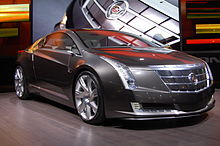 The Cadillac Converj, unveiled at the 2009 North American International Auto Show, shares the Volt's Voltec powertrain.
The Cadillac Converj, unveiled at the 2009 North American International Auto Show, shares the Volt's Voltec powertrain.
- Cadillac Converj
The Cadillac Converj is a plug-in hybrid concept car manufactured by Cadillac, a division of General Motors, and first unveiled at the 2009 North American International Auto Show.[173] The Converj incorporates the propulsion system from the Chevy Volt, including the battery pack and the Voltec powertrain with the 111 kW electric motor, and the four-cylinder engine-generator. The Converj concept has an all-electric range of 40 miles (64 km) and a top speed of 100 mph (160 km/h).[174] In August 2011, General Motors announced that the Converj concept will go into production as the Cadillac ELR.[175]
- Volt MPV5
At the 2010 Auto China show General Motors unveiled the Chevrolet Volt MPV5 Concept. The Volt MPV5 is a plug-in crossover hybrid and has a top speed of 100 mph (160 km/h) and an electric range of 32 miles (51 km). The MPV5 integrates design elements from the Volt, with a body style very similar to the Chevrolet Orlando and four inches larger than its predecessor, Chevrolet HHR.[176][177]
Controversies and criticism
EPA fuel economy testing
Typical EPA's new fuel economy label for an extended-range electric vehicle like the Chevrolet Volt (top), and for a blended or series-parallel plug-in hybrid (bottom)In 2008, General Motors was concerned about how the United States Environmental Protection Agency (EPA) would test the Volt to determine its official fuel economy rating. The controversy centered on whether, by including a gasoline engine, the Volt should be classified as a hybrid rather than an electric car as claimed by General Motors. If tested with the same EPA tests used by other hybrids, the Volt's EPA fuel economy rating would be around 48 mpg-US (4.9 L/100 km; 58 mpg-imp) due to the current EPA test for hybrids disallowing vehicles from boosting their mpg rating using stored battery power. General Motors stated that the Volt is an entirely new type of vehicle which the EPA's current fuel economy tests were not suited to rate and that a new test should be devised for this emerging class of hybrid-electrics.[178] General Motors also advocated for a more simplified mpg calculation method to take into account the range of a plug-in hybrid while running solely on electricity. Because the Volt can travel 40 miles (64 km) on batteries alone, GM argued that most drivers with a daily commute of less than that distance would drive only in electric mode, so long as they recharged their vehicle at work or at home overnight.[179]
The EPA official rating issued in November 2010 included separate fuel economy ratings for all-electric mode and gasoline-only mode, with an overall combined city/highway gasoline-electricity fuel economy rating of 60 mpg-US (3.9 L/100 km; 72 mpg-imp) equivalent (MPG-e).[67][71][72] To address the variability of the fuel economy outcome depending on miles driven between charges, EPA also included in the Volt's fuel economy label a table showing fuel economy and electricity consumed for five different scenarios driven between a full charge, and a never-charge scenario.[67] According to this table the Volt's fuel economy goes up to 168 mpg-US (1.40 L/100 km; 202 mpg-imp) equivalent (MPG-e) if driven 45 miles (72 km) between full charges.[71] Also, in recognition of the multiple operating modes that a plug-in hybrid can be built with (all-electric, blended, and gasoline-only), for the new fuel economy and environment label that will be mandatory in the U.S. beginning in model year 2013, EPA and the National Highway Traffic Safety Administration (NHTSA) issued two separate fuel economy labels for plug-in hybrids. One label is for extended-range electric vehicles, like the Chevy Volt, with two modes: all-electric and gasoline-only; and a second label for blended mode that includes a combination of all-electric, gasoline and electric operation, and gasoline only, like a conventional hybrid vehicle.[180][181]
EPA fuel economy rating
On August 2009, General Motors released its estimated city fuel economy rating for the Volt of 230 mpg-US (1.0 L/100 km; 280 mpg-imp) of gasoline plus 25 kW·h/100 mi (560 kJ/km) of electricity using the EPA's proposed method for evaluating plug-in hybrids.[44][182] The U.S. Environmental Protection Agency (EPA) issued a statement clarifying that the "EPA has not tested a Chevy Volt and therefore cannot confirm the fuel economy values claimed by GM."[44] On July 2010, General Motors recognized that their estimate was based on a formula that never got official approval, and they were awaiting EPA's decision on how the equivalent fuel economy of plug-in hybrids will be estimated.[183]
The official EPA rating was issued in November 2010 EPA and became the agency's first fuel economy label for a plug-in hybrids. The EPA rated the 2011 Volt combined fuel economy at 93 miles per gallon gasoline equivalent (MPG-e) in all-electric mode, and 37 mpg-US (6.4 L/100 km; 44 mpg-imp) in gasoline-only mode, for an overall combined fuel economy rating of 60 mpg-US (3.9 L/100 km; 72 mpg-imp) equivalent (MPG-e). The label also shows the combined city-highway fuel economy in all-electric mode expressed in traditional energy consumption units, rating the Volt at 36 KWh per 100 miles (160 km).[67][72]
Production cost and sales price
In 2009, the Presidential Task Force on the Auto Industry said that "GM is at least one generation behind Toyota on advanced, “green” powertrain development. In an attempt to leapfrog Toyota, GM has devoted significant resources to the Chevy Volt." and that "while the Chevy Volt holds promise, it is currently projected to be much more expensive than its gasoline-fueled peers and will likely need substantial reductions in manufacturing cost in order to become commercially viable."[184] In an April 2009 interview with the president of General Motors' North American operations, Troy Clark stated he was uncertain if the next generation systems following the Volt would be profitable.[185]
A 2009 Carnegie Mellon University study found that a PHEV-40 will be less cost effective than a HEV or a PHEV-7 in all of the scenarios considered, due to the cost and weight of the battery.[186] Jon Lauckner, a Vice President at General Motors, responded that the study did not consider the inconvenience of a 7 miles (11 km) electric range and that the study's cost estimate of US$1,000 per kWh for the Volt's battery pack was "many hundreds of dollars per kilowatt hour higher" than what it costs to make today."[187]
After the Volt's sales price was announced in July 2010, a Washington Post editorial expressed its concern because as "for the near future, electric cars will be far too expensive for anyone but upper-income Americans. The only way to sell them, even to the well-off, will be with a large federal subsidy. The newspaper explained that the average new car sold for US$28,350 in 2008, while the plug-in Volt, by contrast, will cost US$41,000, less the US$7,500-per-car federal tax credit, and that includes other subsidies derived from the US$2.4 billion advanced vehicle technology grant program part of the economic stimulus plan. The Washington Post concludes that "common sense suggests the likeliest purchasers will be upscale consumers who already own gasoline-powered cars for heavy-duty driving, live in a single-family home with an electric outlet in the garage – and can afford a green experiment."[188]
 President Barack Obama behind the wheel of a new Chevy Volt during his tour of the General Motors Auto Plant in Hamtramck, Michigan
President Barack Obama behind the wheel of a new Chevy Volt during his tour of the General Motors Auto Plant in Hamtramck, Michigan
In an OpEd published in the New York Times, Edward Niedermeyer, editor of the website The Truth About Cars, criticized General Motors because the Volt costs US$41,000 before relevant tax breaks despite billions of dollars of government loans and grants for the Volt’s development and production. "And instead of the sleek coupe of 2007, it looks suspiciously similar to a Toyota Prius. It also requires premium gasoline, seats only four people (the battery runs down the center of the car, preventing a rear bench) and has less head and leg room than the US$17,000 Chevrolet Cruze, which is more or less the non-electric version of the Volt." He also complained that to make the Volt more affordable, General Motors decided to offer a US$350-a-month lease for 36 months, but limited to only 12,000 miles (19,000 km) per year, or about 33 miles (53 km) per day. If an owner wants to keep below the lease mileage limit and he charges his Volt every evening, which is good for 40 miles (64 km) of battery power, this Volt owner would rarely use its expensive range-extending gasoline engine. "No wonder the Volt’s main competition, the Nissan Leaf, forgoes the additional combustion engine — and ends up costing $8,000 less as a result."[189]
General Motors CEO Edward Whitacre Jr. rejected as "ridiculous" criticism that the Volt's price is too expensive. He said that "I wish we had thousands more (Volts) but we don't. I think it's a very fair price. It's the only car that will go coast to coast on electricity without plugging it in, and nobody else can come close."[190] A G.M. spokesman also commented they are not worried about the critics of the price and commented that the US$350 leasing price is very affordable, nearly on par with Nissan's electric Leaf.[191]
Despite the federal government being the major GM shareholder due to the 2009 government-led bankruptcy of the automaker, during a press briefing at the White House an administration official clarified that the federal government did not have any input on the controversial pricing of the 2011 Chevrolet Volt. The Treasury official said that "We do not tell General Motors what to charge for its cars... we don't tell them what to charge for the Volt. We're not going to tell them what to charge for the Chevrolet Cruze."[192]
There have been also complaints regarding price markups due to the initial limited availability. The New York Times reported in August 2010 that several dealers were charging between US$5,000 to US$12,000 above General Motors's recommended price.[193] At least in one case a US$20,000 mark up in California was reported by Edmunds.com.[194] Even though the carmaker cannot dictate vehicle pricing to its dealers, a G.M. spokesman said that the company had requested the dealers to keep prices in line with the company’s suggested retail price.[193]
In May 2011 the National Legal and Policy Center denounced that some Chevrolet dealers were selling Volts to other dealers and claiming the US$7,500 federal tax credit for themselves. Then the dealers who bought the Volts sell them as used cars with low mileage to private buyers, who no longer qualify for the credit. General Motors acknowledged that 10 dealer-to-dealer Volt sales had taken place among Chevrolet dealers, but the carmaker said they do not encourage such practice.[195][196]
Battery charging emissions
Main article: Greenhouse gas emissions in plug-in hybridsSee also: Air pollution and greenhouse gas emissions in plug-in electric vehiclesThe EPA rated the Volt's tailpipe emissions at 84 grams of carbon dioxide per mile (52.5 CO2 g/km).[72][76] These are the greenhouse emissions at the point of operation. Charging the Volt's batteries still results in some greenhouse gas emissions from electricity generation at the local power station.[197] However, under most conditions CO2 output is less than other low emission vehicles and in the best case emissions are nearly zero.[198] General Motors claims that the Volt saves 4.4 metric tons in CO2 emissions annually compared to a typical U.S. car.[199]
UK based Auto Express magazine claims in a non-scientific study to have calculated that the generation of electricity for charging the batteries in the Volt resulted in emissions equivalent to 124.2 g/km (199 g/mi) of CO2 for electric-only trips (those not involving the use of any on board fuel), based on government figures for the average CO2 emissions from power stations. According to Auto Express, this is more CO2 than the BMW 118d produces.[200] Using CO2 emissions data for the United States, the Auto Express estimate can be shown to imply Volt's plug-to-wheel efficiency of approximately 340 Wh/mile (212 Wh/km) – somewhat high for electric vehicles (Tesla Roadster is EPA rated at 280 Wh/mile (175 Wh/km) plug-to wheel), but within the realm of possibility.
Reception
Awards and recognition
The Chevrolet Volt won the 2011 Motor Trend Car of the Year award.
The Volt has received awards from multiple organizations:
- U.S. organizations
- 2009 Green Car Vision Award by the Green Car Journal at the Washington Auto Show for "a bold and far-reaching approach that promises to bring an exceptionally fuel efficient model to consumers at reasonable cost."[201]
- 2011 Car and Driver Ten Best Cars. For the first time ever Car and Driver magazine included an electrically powered car among its 10 best.[202]
- 2011 Motor Trend Car of the Year. The magazine commented that "In the 61-year history of the Car of the Year award, there have been few contenders as hyped – or as controversial – as the Chevrolet Volt."[203]
- 2011 Green Car of the Year by Green Car Journal. The magazine editors explained that "This award welcomes a new genre of mass-production electric vehicles to the consumer market, with the Volt as the first-ever electric vehicle to take top prize."[204]
- 2011 Automobile of the Year by Automobile Magazine. The editors commented that the Volt "...is genuinely an all-new car, in the most simplistic sense as well as in the greater notion that the Volt is unlike any vehicle we have ever driven."[205]
- 2011 North American Car of the Year announced at the 2011 North American International Auto Show. Forty-nine American and Canadian automobile writers chose the Volt. The nominees were judged based on "innovation, design, safety, handling, driver satisfaction and value".[206]
- Listed among the 2011 Greenest Vehicles of the Year by the American Council for an Energy-Efficient Economy.[207][208]
- 2012 Best Resale Value Award in the category of electric cars by Kelley Blue Book.[137]
- International organizations
- 2009 Festival Automobile International selected the Chevrolet Volt for the 2009 Grand Prize for Environment.[211]
- 2011 World Green Car announced at the 2011 New York Auto Show.[212]
- European organizations
- 2012 Car of the Year in Denmark. In October 2011, 18 Danish motor journalists chose the Opel Ampera as "Car of the Year 2012" by a wide margin, despite being more expensive than the family cars the award usually goes to.[213]
Reviews and test drives
On October 10, 2010, General Motors made the Volt available for 150 journalists and analysts to test drive the plug-in on open highways around Detroit. General Motors organized a hypermiling competition among the journalists attending the official press launch event over a 43.2 mi (69.5 km) distance. The winner achieved over 50 mi (80 km) of electric range while most participants managed just over 46 mi (74 km).[214]
The Detroit News reported an all-electric range of 32 miles (51 km) driving in a "very un-eco-friendly manner" and a total fuel consumption of 0.9 US gallons (3.4 l; 0.75 imp gal) for the 75 miles (121 km) trip.[215] USA Today reported an EV range of 40 miles (64 km) driving more than an hour of stop-and-go through Detroit suburbs and the rolling Michigan countryside.[216] Detroit Free Press reported an all-electric range of 46.2 miles (74.4 km) driving normally and using the air conditioning.[217] The following table summarizes the results reported by other specialized media, and some other more extended tests that took place later.
Summary of the Volt's all-electric range and fuel economy results
published by the specialized press and industry analystsReviewer Driving
conditionAll-electric
rangeFuel economy
Gasoline only
(Charge-sustaining mode)Fuel economy
EV mode
(Charge-depleting mode)Comments miles km mpg-US L/100 km mpg-e L/100 km-e EPA ratings[67][71] Repeatable, EPA five-cycle tests designed to simulate varying driving conditions and climate controls 35 56 37 6.4 93 2.5 All ratings combined city and highway
Overall combined gasoline-electric fuel economy rating of 60 mpg-US (3.9 L/100 km; 72 mpg-imp) equivalent (mpg-e)Popular Mechanics[218] Two-lane roads under "lead-foot" style driving, A/C off 31 50 n.a. n.a City streets under normal style driving, A/C on 35 56 31.7 7.42 n.a. Highway only, cruising at 78 mph 33 53 36 6.5 n.a Over 600 miles (970 km) Consumer Reports Short test: normal daily commute, climate control in Auto mode[219] 33 53 30 7.8 89 2.6 Outdoor temperatures averaged about 50 °F (10 °C) Extended test: normal daily commute, cold winter time[220] 25 40 30 7.8 n.a. Outdoor temperatures averaged about 20 to 30 °F (-7 to -1 °C). Almost1,000 miles (1,600 km). Average combined 53 miles per US gallon (4.4 L/100 km) Motor Trend Normal everyday driving[221] n.a n.a 126.7 1.856 Over 299 miles (481 km) City, hard-core mountain roads and freeway, A/C on[221] 36.3 58.4 n.a 74.6 3.15 Over 122 miles (196 km) Extended test on cold winter time
(February-mid April)[222]22-30[65] 35-48 n.a 75.3 3.12 Over 3,090 miles (4,970 km), 2,259 city/831 highway. Combined gasoline/electricity average fuel economy of 49.26 miles per US gallon (4.775 L/100 km) equivalent. Average cost US$0.08/mi (US$0.05/km). Maximum EV range: 39.4 miles (63.4 km) at 50 °F (10 °C).[222] Edmunds.com[223] "Light-footedly" in typical traffic driving 47 76 n.a n.a Normal driving three persons on board 42 68 n.a n.a Car and Driver[224] Highway commuting with the 80 mph flow of traffic 26 42 Average
35Average
6.7Average
74Average
3.2Energy-equivalent efficiency (mpgge) over152 miles (245 km) Fast driving back-road loop 31 50 Autoblog[225] Hypermiling without disrupting traffic 47.5 76.4 36 6.5 n.a. Battery-level meter still showed 10 miles (16 km) of range remaining Green Car Reports[226] Hypermiling in road with speed limits under 45 mph 43 69 n.a. n.a. Battery-level meter still showed 3 miles (4.8 km) of range remaining Normal driving, no freeway n.a. 40.3 5.84 73.9 3.18 Over 160 miles, 73.0 miles (117.5 km) on electricity and 86.8 miles (139.7 km) on gasoline. Los Angeles Times[227] Highway driving, freeway speed n.a. n.a. 90.3 2.60 Over 72.5 miles, 40.8 in electric mode and 31.7 on gasoline Highway driving, freeway speed n.a. 39 6.0 n.a. Over 400 miles (640 km) from Los Angeles to Oakland MSNBC[228] Highway driving, freeway speed 32.9 52.9 40 5.9 80 2.9 Over 873 miles (1,405 km) from Seattle to San Francisco See also
- Chevrolet Spark EV
- GM Voltec platform
- Electric car
- EV Project
- General Motors EV1 – all-electric car from the 1990s
- General Motors XP-883 – plug-in hybrid vehicle from 1969
- General Motors Hy-wire – hydrogen powered
- General Motors Sequel – hydrogen powered
- Genset trailer
- Government incentives for plug-in electric vehicles
- List of modern production plug-in electric vehicles
- Magna International
- Opel Flextreme – Diesel plug-in hybrid by Opel
References
- ^ a b c d e f "2011 Volt". Chevrolet. http://www.chevrolet.com/volt/features-specs/. Retrieved 2011-01-03.
- ^ Michael A. Miller, Alan G. Holmes, Brendan M. Conlon, and Peter J. Savagian (2011-04-12). "The GM “Voltec” 4ET50 Multi-Mode Electric Transaxle". SAE International - Technical Papers. doi:10.4271/2011-01-0887. http://papers.sae.org/2011-01-0887/. Retrieved 2011-10-30.
- ^ a b U.S. Department of Energy and U.S. Environmental Protection Agency (2011-06-03 (Last updated)). "2011 Most Efficient Cars by EPA Size Class* (including Electric Drive Vehicles)". fueleconomy.gov. http://www.fueleconomy.gov/feg/best/bestworstnf.shtml. Retrieved 2011-06-03. Note: The Volt is the most fuel efficient in the compact class, while the Nissan Leaf is the most fuel efficient in the midsize class and across all classes. Excluding electric drive vehicles, the Toyota Prius becomes the most fuel efficient midsize.
- ^ a b "2011 Chevrolet Volt Rated at 93 MPGe". MiamiHerald.com. 2010-11-24. http://www.miamiherald.com/2010/11/24/1942214/2011-chevrolet-volt-rated-at-93.html. Retrieved 2011-06-03.
- ^ a b U.S. Environmental Protection Agency (2011-11-07). "2011–12 Chevrolet Volt". FuelEconomy.gov (US DoE). http://www.fueleconomy.gov/feg/phevsbs.shtml. Retrieved 2011-11-07.
- ^ "SAE paper 2008-01-0458: The Electrification of the Automobile: From Conventional Hybrid, to Plug-in Hybrids, to Extended-Range Electric Vehicles". Society of Automotive Engineers (SAE). 2008. http://media.gm.com/content/dam/Media/microsites/product/volt/docs/paper.pdf. Retrieved 2011-05-14.
- ^ Paul Stenquist (2010-10-11). "G.M. ‘Officially’ Introduces 2011 Chevrolet Volt Amid Controversy". New York Times. http://wheels.blogs.nytimes.com/2010/10/11/g-m-officially-introduces-2011-chevrolet-volt-amid-controversy/. Retrieved 2010-10-11.
- ^ "Chevrolet Volt Hits Road, Ahead of Schedule". The New York Times. 2009-06-25. http://wheels.blogs.nytimes.com/2009/06/25/chevrolet-volt-hits-road-ahead-of-schedule/. Retrieved 2011-06-02.
- ^ Jonathan Oosting (2010-10-12). "Is the Chevrolet Volt a true electric car? General Motors defends EV label". MLive.com. http://www.mlive.com/auto/index.ssf/2010/10/is_the_chevrolet_volt_a_true_e.html. Retrieved 2010-06-02.
- ^ Kuchment, Anna (January 2011). "Practically Green: A Q&A with the Chevy Volt's Chief Engineer". Scientific American (Nature America) 304 (1): p. 25. ISSN 0036-8733. http://www.scientificamerican.com/article.cfm?id=practically-green. Retrieved 2011-03-27.
- ^ a b c d e f g h Norman Mayersohn (2010-10-15). "Sorting Myth From Fact as Volt Makes Its Debut". New York Times. http://www.nytimes.com/2010/10/17/automobiles/17VOLT.html?_r=1&scp=1&sq=Chevy%20Volt&st=cse. Retrieved 2010-10-17.
- ^ Frank Markus (2010-10-10). "Unbolting the Chevy Volt to See How it Ticks". Motor Trend. http://www.motortrend.com/features/editorial/1010_unbolting_the_chevy_volt_to_see_how_it_ticks/index.html. Retrieved 2010-10-11.
- ^ a b c d "Chevy Volt Delivers Novel Two-Motor, Four-Mode Extended Range Electric Drive System; Seamless Driver Experience Plus Efficiency". Green Car Congress. 2010-10-20. http://www.greencarcongress.com/2010/10/chevy-volt-delivers-novel-two-motor-four-mode-extended-range-electric-drive-system-seamless-driver-e.html#more. Retrieved 2010-10-21.
- ^ a b John Voelcker (January 2007). "Lithium Batteries for Hybrid Cars". IEEE Spectrum. http://www.spectrum.ieee.org/green-tech/advanced-cars/lithium-batteries-for-hybrid-cars. Retrieved 2011-05-14.
- ^ a b c d "GM Introduces E-Flex Electric Vehicle System; Chevrolet Volt the First Application". Green Car Congress. 2007-01-06. http://www.greencarcongress.com/2007/01/gm_introduces_e.html?cid=27360790. Retrieved 2011-05-14.
- ^ Edsall, Larry (2010). Chevrolet Volt: Charging into the Future. Motorbooks. pp. 43. ISBN 978-0760338933.
- ^ "Bob Lutz: The Man Who Revived the Electric Car | Newsweek Next 2008". Newsweek.com. http://www.newsweek.com/id/81580. Retrieved 2009-08-19.
- ^ a b c d Edsall, Larry (2010). op. cit. pp. 91–16.
- ^ Fletcher, Seth (2011). Bottled Lightning: Superbatteries, Electric Cars, and the New Lithium Economy. Hill and Wang, New York. pp. 4–5. ISBN 978-0809030538.
- ^ "GM to unveil Volt electric concept car". Associated Press (msnbc.com). 2007-01-07. http://www.msnbc.msn.com/id/16503845/ns/business-autos/t/gm-unveil-volt-electric-concept-car/. Retrieved 2011-05-15.
- ^ a b Edsall, Larry (2010). op. cit. pp. 29–33.
- ^ a b Abuelsamid, Sam (2007-01-07). "A look at the GM E-Flex platform". AutoBlogGreen.com. http://www.autobloggreen.com/2007/01/07/detroit-auto-show-general-motors-e-flex-platform/. Retrieved 2011-05-15.
- ^ Edsall, Larry (2010). op. cit. pp. 35.
- ^ a b Fletcher, Seth (2011). op. cit. pp. 73–74.
- ^ Lutz, Bob (2011). Car Guys vs. Bean Counters: The Battle for the Soul of American Business. Portfolio Hardcover, Penguin Group. ISBN 978-1591844006. Location 2234 Kindle edition.
- ^ "Chevrolet Volt Leads General Motors Into Its Second Century". GM Communications. 2008-09-16. http://www.prefix.com/Downloads/Volt.pdf. Retrieved 2009-12-21.
- ^ Phil Patton (2008-12-19). "Edgy, Yet Still Aerodynamic". The New York Times. http://www.nytimes.com/2008/12/21/automobiles/21AERO.html?pagewanted=1. Retrieved 2011-05-15.
- ^ Edsall, Larry (2010). op. cit. pp. 71.
- ^ Jim Motavalli (2008-09-21). "G.M. Tones Down the Volt". The New York Times. http://query.nytimes.com/gst/fullpage.html?res=9A0DEED9113DF932A1575AC0A96E9C8B63. Retrieved 2011-05-15.
- ^ a b c Ultimate Factories: Chevy Volt. National Geographic Channel. 2009. http://channel.nationalgeographic.com/series/man-made/4905/Videos#tab-Videos/07881_00. Retrieved 2011-05-14.
- ^ Squatriglia, Chuck (2008-09-16). "Inside the Design Process of the Volt". Wired.com. http://www.wired.com/cars/coolwheels/news/2008/09/volt_revealed/. Retrieved 2011-05-15.
- ^ "2011 Chevrolet Volt Full Test – Road Test – Auto Reviews". Car and Driver. http://www.caranddriver.com/reviews/car/10q4/2011_chevrolet_volt-feature_test. Retrieved 2010-10-23.
- ^ a b c d Edsall, Larry (2010). op. cit. pp. 48–57.
- ^ Sam Abuelsamid (2007-06-05). "GM awards two battery development contracts for Chevy Volt". AutoblogGreen. http://green.autoblog.com/2007/06/05/breaking-gm-awards-two-battery-development-contracts-for-chevy/.
- ^ a b c d e f Fletcher, Seth (2011). op. cit. pp. 84–89.
- ^ Wood, Eric; Alexander, Marcus; Bradley, Thomas H. (2011). "Investigation of battery end-of-life conditions for plug-in hybrid electric vehicles". Journal of Power Sources 196 (11): 5147–5154. doi:10.1016/j.jpowsour.2011.02.025. http://www.engr.colostate.edu/~thb/Publications/POWER14185_nocover.pdf. Retrieved 2011-05-22. See pp. 5149
- ^ Blanco, Sebastian (2008-04-03). "GM's Chevy Volt update: All systems go, Malibu-based li-ion mules coming soon". AutoblogGreen. http://www.autobloggreen.com/2008/04/03/gms-chevy-volt-update-all-systems-go-malibu-based-mules-comin/. Retrieved 2010-10-23.
- ^ Kim, Soyoung (2008-10-22). "LG Chem to supply GM Volt batteries". Reuters. http://www.reuters.com/article/rbssChemicalsCommodity/idUSN2239779020081022?sp=trueh. Retrieved 2009-08-11.
- ^ Johnson, Drew (2008-10-24). "GM inks Chevrolet Volt battery contract". Leftlane. http://www.leftlanenews.com/gm-inks-chevrolet-volt-battery-contract.html. Retrieved 2009-08-11.
- ^ Joe Lawlor General Motors confirms intention to manufacture engine for battery-powered Volt in Flint, The Flint Journal, July 29, 2008
- ^ Brooke, Lindsay (2009-11-22). "For the Volt, How's Life After 40 (Miles)?". The New York Times. http://www.nytimes.com/2009/11/22/automobiles/autoreviews/22-chevy-volt.html. Retrieved 2011-06-02.
- ^ "GM’s Response to the GM-Volt.com First Chevy Volt to be Built Post and Comments". GM-VOLT: Chevy Volt Electric Car Site. 2009-03-25. http://gm-volt.com/2009/03/25/gms-response-to-the-gm-voltcom-first-chevy-volt-to-be-built-post-and-comments. Retrieved 2009-03-29.
- ^ a b Jim Motavalli (2009-06-02). "G.M. Says Chevy Volt Is Still on Track". New York Times. http://wheels.blogs.nytimes.com/2009/06/02/gm-says-chevy-volt-is-still-on-track/. Retrieved 2009-06-02.
- ^ a b c Vlasic, Bill; Bunkley, Nick (August 11, 2009). "G.M. Puts Electric Car’s City Mileage in Triple Digits". New York Times. http://www.nytimes.com/2009/08/12/business/12auto.html. Retrieved 2009-08-11.
- ^ "GM builds first Chevy Volt, says production line practice run OK". USA Today. 2010-03-31. http://content.usatoday.com/communities/driveon/post/2010/03/gm-finishes-building-first-chevy-volt-battery-car-using-production-tooling-says-the-practice-run-was-ok/1. Retrieved 2010-04-05.
- ^ "First Pre-Production Chevy Volt Rolls Off Line". Green Car Congress. 2010-04-02. http://www.greencarcongress.com/2010/04/volt-20100402.html. Retrieved 2010-04-05.
- ^ a b Alisa Priddle (2010-11-30). "GM to hire 1,000 in Michigan". The Detroit News. http://detnews.com/article/20101130/AUTO01/11300386/GM-to-create-1-000-new-technology-jobs. Retrieved 2010-11-30.
- ^ a b Bill Vlasic (2010-11-30). "G.M. to Hire 1,000 to Engineer More Electric Cars". New York Times. http://www.nytimes.com/2010/12/01/business/energy-environment/01volt.html?ref=automobiles. Retrieved 2010-11-30.
- ^ "Rick Hendrick wins first retail Chevy Volt for $225,000". Autoblog. 2010-12-17. http://www.autoblog.com/2010/12/17/rick-hendrick-wins-first-retail-chevy-volt-for-225-000/. Retrieved 2010-12-17.
- ^ a b "First Chevy Volts Reach Customers, Will Out-Deliver Nissan in December". plugincars.com. 2010-12-16. http://www.plugincars.com/first-chevy-volts-reach-customers-will-out-deliver-nissan-december-106575.html. Retrieved 2010-12-17.
- ^ a b "Plug Standard Needed For Electric Car-Charging Cord Interface: SAE J1772". 2009-03-30. http://gm-volt.com/2009/04/16/plug-standard-needed-for-electric-car-charging-cord-interface-sae-j1772/#comment-107648. Retrieved 2009-04-06.
- ^ a b c d e General Motors (Press Release) (2010-10-10). "Chevrolet Volt’s Revolutionary Voltec Electric Drive System Delivers Efficiency With Performance". ebookbrowse. http://ebookbrowse.com/10-chevrolet-volt-propulsion-121710-doc-d73975429. Retrieved 2011-05-16.
- ^ "Why the Volt Requires Premium Gasoline". GM-Volt. 2010-07-30. http://gm-volt.com/2010/07/30/why-the-volt-requires-premium-gasoline/. Retrieved 2011-06-05.
- ^ Mike Magrath (2010-07-29). "2011 Chevy Volt : Fill 'er Up. With Premium". Edmunds.com. http://blogs.insideline.com/straightline/2010/07/2011-chevy-volt--fill-er-up-with-premium.html. Retrieved 2011-06-05.
- ^ Sam Abuelsamid (2010-09-13). "New problem, new solution: Chevrolet Volt's "maintenance mode" will burn gas to prevent aging". AutoblogGreen. http://green.autoblog.com/2010/09/13/new-problem-new-solution-chevrolet-volts-maintenance-mode-w/. Retrieved 2010-09-13.
- ^ "900 Miles Reliability Report in the Chevy Volt". Popular Mechanics. 2010-10-10. http://www.popularmechanics.com/cars/reviews/hybrid-electric/volt-reliability-report-test. Retrieved 2010-10-11.
- ^ "Cooling Fins Help Keep Chevrolet Volt Battery at Ideal Temperature". GM Volt Media Portal. 2011-02-14. http://media.gm.com/content/product/public/us/en/volt/home.detail.html/content/Pages/news/us/en/2011/Feb/0214_battery. Retrieved 2011-04-28.
- ^ EVAmerica Baseline Performance Testing, 1999 General Motors EV1 with NiMH Batteries. US Department of Energy (DOE), Idaho National Laboratory (INL), Advanced Vehicle Testing Activity (AVTA). 2002-07-30. http://avt.inel.gov/pdf/fsev/eva/ev1_eva.pdf. Retrieved 2009-10-08.
- ^ EVAmerica Baseline Performance Testing, 1997 General Motors EV1 with PbA Batteries. US Department of Energy (DOE), Idaho National Laboratory (INL), Advanced Vehicle Testing Activity (AVTA). 2002-08-02. http://avt.inel.gov/pdf/fsev/eva/ev1_eva.pdf. Retrieved 2009-10-08.
- ^ General Motors (2001-04-17). "EV1 – specs". http://www.evchargernews.com/CD-A/gm_ev1_web_site/specs/specs_specs_top.htm. Retrieved 2009-10-09.
- ^ a b c "Chevrolet Volt Battery Pack Carries Standard Eight-Year, 100,000-Mile Warranty". Green Car Congress. 2010-07-14. http://www.greencarcongress.com/2010/07/volt-20100714.html. Retrieved 2011-05-23.
- ^ Tom Zeller Jr. (2010-07-14). "G.M. to Offer 8-Year Guarantee for New Electric Car’s Battery". New York Times. http://www.nytimes.com/2010/07/15/business/15auto.html?_r=1&ref=automobiles. Retrieved 2010-07-15.
- ^ Martin LaMonica (2010-11-08). "GM envisions refreshing EV batteries". CNET News Green Tech. http://news.cnet.com/8301-11128_3-20022049-54.html. Retrieved 2011-04-28.
- ^ a b c d "2011 Chevrolet Volt Road Test Specs". Edmunds.com. http://www.edmunds.com/chevrolet/volt/2011/road-test-specs.html. Retrieved 2011-06-05.
- ^ a b c Frank Markus (2011-04-13). "Arrival: 2011 Chevrolet Volt". Motor Trend. http://www.motortrend.com/roadtests/oneyear/1106_2011_chevrolet_volt_arrival/index.html. Retrieved 2011-05-08. Over 2,360 miles (3,800 km) driven
- ^ "2011 Chevrolet Volt Receives New Fuel Economy Label From EPA | Volt". Chevroletvoltage.com. 2010-11-24. http://www.chevroletvoltage.com/index.php/volt-blog/18-volt/2240-2011-chevrolet-volt-receives-new-fuel-economy-label-from-epa.html. Retrieved 2011-06-02.
- ^ a b c d e f g "Volt receives EPA ratings and label: 93 mpg-e all-electric, 37 mpg gas-only, 60 mpg-e combined". Green Car Congress. 2010-11-24. http://www.greencarcongress.com/2010/11/volt-20101124.html#more. Retrieved 2010-11-24.
- ^ Fred Meier (2010-11-24). "Volt is rated 93 mpg on electricity alone, 37 mpg on gas generator". USA Today. http://content.usatoday.com/communities/driveon/post/2010/11/volt-is-rated-93-mpg-on-electricity-alone-37-mpg-on-gas-generator/1. Retrieved 2010-11-24.
- ^ "For Earth Day, we push the Chevrolet Volt to its limits--and beyond". Autoweek. 2011-04-22. http://www.autoweek.com/article/20110422/CARREVIEWS/110429929. Retrieved 2011-05-14.
- ^ a b Torben Arent (2011-09-27). "Opels miljøbil klar: 83 km/l" (in Danish). United Car Owners. http://www.fdm.dk/nyheder/opels-miljoebil-klar-83-kml. Retrieved 2011-10-18. Title translation: Opel's eco-car ready: 83 km / l
- ^ a b c d U. S. Environmental Protection Agency and U.S. Department of Energy (2011-05-04 (last updated)). "2011 Chevrolet Volt". Fueleconomy.gov. http://www.fueleconomy.gov/feg/phevsbs.shtml. Retrieved 2011-05-08.
- ^ a b c d e David Bailey and Kevin Krolicki (2010-11-24). "Chevy Volt tops Prius in fuel economy rating". Reuter. http://www.reuters.com/article/idUSTRE6AN65K20101124. Retrieved 2010-11-24.
- ^ General Motors (2011-04-21). "Going Pump Free: Volt Owners Go 1,000 Miles Between Fill-Ups". PR Newswire. http://www.prnewswire.com/news-releases/going-pump-free-volt-owners-go-1000-miles-between-fill-ups-120351134.html. Retrieved 2011-04-28.
- ^ a b General Motors (2011-11-16). "2012 Volt Moves Into California's HOV Fast Lane". AutoblogGreen. http://green.autoblog.com/2011/11/16/new-enhat-pzev-chevy-volt-ready-for-california-hov-access-extra/#continued. Retrieved 2011-11-17. See details in GM Press Release.
- ^ a b Kurt Hedevang (2011-09-28). "Opel Ampera below 600,000 DKK" (in Danish). Consumer Online. http://fpn.dk/motor/bil/article2560207.ece. Retrieved 2011-10-14.
- ^ a b c Nelson Ireson (2010-11-24). "2011 Chevrolet Volt Gets 93 MPGe EV Rating, 60 MPG Combined". GreenCarReports.com. http://www.greencarreports.com/blog/1051889_2011-chevrolet-volt-gets-93-mpge-ev-rating-60-mpg-combined. Retrieved 2010-11-25.
- ^ "2011 Chevy Volt Classified As ULEV by CARB, Emits More CO Than Prius, Ineligible For Carpool Stickers". Edmunds.com. 2010-10-26. http://blogs.insideline.com/straightline/2010/10/2011-chevy-volt-classified-as-ulev-by-carb-emits-more-co-than-prius-ineligible-for-carpool-stickers.html. Retrieved 2010-11-25.
- ^ Cheryl Jensen (2011-04-26). "Chevrolet Volt and Nissan Leaf Earn Top Marks in First U.S. Crash Tests". The New York Times. http://wheels.blogs.nytimes.com/2011/04/26/chevrolet-volt-and-nissan-leaf-earn-top-marks-in-first-u-s-crash-tests/. Retrieved 2011-04-27.
- ^ Sebastian Blanco (2011-06-03). "Chevy Volt earns five-star NHTSA crash rating". AutoblogGreen. http://green.autoblog.com/2011/06/03/chevy-volt-earns-five-star-nhtsa-crash-rating-w-videos. Retrieved 2011-06-03.
- ^ a b "General Motors Kicks Off National Electric Vehicle Training Tour For First Responders". Green Car Congress. 2010-08-27. http://www.greencarcongress.com/2010/08/gmfr-20100827.html. Retrieved 2011-11-11.
- ^ General Motors (2011-01-19). "Detroit First Responders Get Electric Vehicle Safety Training". General Motors News. http://media.gm.com/content/media/us/en/gm/news.detail.html/content/Pages/news/us/en/2011/Jan/0118_NFPA. Retrieved 2011-11-12.
- ^ General Motors (2011-03-31). "First Responder Vehicle Guides". U.S. Fire Administration. http://www.usfa.fema.gov/fireservice/subjects/emr-isac/infograms/ig2011/13-11.shtm. Retrieved 2011-11-12.
- ^ Jim Motavalli (2010-06-01). "Electric Car Warning Sounds: Don’t Expect Ring Tones". New York Times. http://wheels.blogs.nytimes.com/2010/06/01/electric-car-warning-sounds-dont-expect-ringtones/. Retrieved 2010-06-02.
- ^ David Shepardson (2011-01-04). "Obama signs law to require 'quiet' cars to get noisier". The Detroit News. http://detnews.com/article/20110104/AUTO01/101040430/Obama-signs-law-to-require-%E2%80%98quiet%E2%80%99-cars-to-get-noisier. Retrieved 2011-01-05.
- ^ a b Christopher Jensen (2011-11-11). "Chevy Volt Fire Prompts Federal Investigation Into Lithium-Ion Batteries". The New York Times. http://wheels.blogs.nytimes.com/2011/11/11/chevy-volt-fire-prompts-federal-investigation-into-lithium-ion-batteries/?ref=automobiles. Retrieved 2011-11-11.
- ^ a b Jeff Green, David Welch and Angela Greiling Keane (2011-11-11). "GM Volt Fire Prompts Probe of Lithium Batteries". Bloomberg. http://www.bloomberg.com/news/2011-11-11/gm-volt-battery-fire-is-said-to-prompt-u-s-probe-into-electric-car-safety.html. Retrieved 2011-11-11.
- ^ Nick Bunkley (2011-11-11). "Batteries in Electric Cars Examined After Chevy Volt Fire". The New York Times. http://www.nytimes.com/2011/11/12/business/energy-environment/regulators-examine-electric-car-batteries-after-fire.html?_r=1&ref=electricvehicles. Retrieved 2011-11-11.
- ^ John Voelcker (2011-11-01). "Third Fire Consumes a Chevy Volt Electric Car: Perspective". Green Car Reports. http://www.greencarreports.com/news/1068533_third-fire-consumes-a-chevy-volt-electric-car-perspective. Retrieved 2011-11-11.
- ^ Larry Greenemeier (2010-01-06). "Charge 'Er Up: OnStar's New Mobile App Keeps Tabs on Chevy Volt Recharge System". Scientific American. http://www.scientificamerican.com/article.cfm?id=onstar-chevy-volt-mobile-app. Retrieved 2011-06-02.
- ^ a b c d e f g "Chevrolet Volt MSRP Starts at $41,000, $33,500 Net of Full Federal Credit; 3-year Lease Program with Option to Buy". Green Car Congress. 2010-07-27. http://www.greencarcongress.com/2010/07/chevrolet-volt-msrp-starts-at-41000-33500-net-of-full-federal-credit-3year-lease-program-with-option.html#more. Retrieved 2010-07-27.
- ^ a b Jim Motavalli (2010-07-28). "The $41,000 Question: Is the Chevy Volt Worth the Money?". New York Times. http://wheels.blogs.nytimes.com/2010/07/28/the-41000-question-is-the-chevy-volt-worth-the-money/?hpw. Retrieved 2010-07-31.
- ^ a b c d e "Chevrolet begins taking orders in all 50 US states for 2012 Volt; $1K drop in starting price". Green Car Congress. 2011-06-10. http://www.greencarcongress.com/2011/06/volt-20110610.html. Retrieved 2011-06-10.
- ^ a b c d e Eric Loveday (2011-06-10). "2012 Chevrolet Volt priced at $39,995*, now available to order nationwide". AutoblogGreen. http://green.autoblog.com/2011/06/10/2012-chevrolet-volt-priced-at-39-995-now-available-to-order-n/. Retrieved 2011-06-10.
- ^ Terlep, Sharon; Aguilar, Louis (2007-09-29). "Detroit to build GM's car of future". Detroit News. http://www.detnews.com/apps/pbcs.dll/article?AID=/20070929/AUTO01/709290383/1148.
- ^ Fonger, Ron (2009-01-13). "Chevy Volt's first range-extending engines will come from Austria, not Flint". Flint Journal. http://www.mlive.com/naias/index.ssf/2009/01/volts_first_rangeextending_eng.html. Retrieved 2009-01-15.
- ^ General Motors News (2010-11-24). "GM to Invest $163 Million, Retain 184 Jobs in Three Plants". http://media.gm.com/content/media/us/en/news/news_detail.html/content/Pages/news/us/en/2010/Nov/1124_pt_flint. Retrieved 2011-05-19.
- ^ "GM investing $109M in Mich plants to support 1.4L Ecotec engines". Green Car Congress. 2011-05-13. http://www.greencarcongress.com/2011/05/gm-investing-109m-in-mich-plants-to-support-14l-ecotec-engines-general-motors-will-invest-109-million-in-its-operations.html. Retrieved 2011-05-19.
- ^ "Chevrolet Increases Projected 2012 Volt Production Capacity by 50 Percent". Car and Driver. 2010-07-30. http://blog.caranddriver.com/chevrolet-increases-projected-2012-volt-production-capacity-by-50-percent/. Retrieved 2010-08-03.
- ^ a b c d "Chevrolet Volt plant prepping for boost in Volt and Ampera production; exports to Canada, China and Europe this year". Green Car Congress. 2011-05-19. http://www.greencarcongress.com/2011/05/volt-20110519.html. Retrieved 2011-05-19.
- ^ Chrissie Thompson (2011-05-19). "GM raises Volt output target". Detroit Free Press. http://www.freep.com/article/201105190300/BUSINESS0101/105190632. Retrieved 2011-05-20.
- ^ a b David Shepardson (2011-07-19). "GM restarts Volt production". The Detroit News. http://detnews.com/article/20110719/AUTO01/107190386/GM-restarts-Volt-production. Retrieved 2011-07-19.
- ^ a b David Jolley (2011-08-04). "Opel/Vauxhall to receive 10,000 Amperas from GM next year". Automotive News Europe. http://www.autonews.com/apps/pbcs.dll/article?AID=/20110804/ANE/110809903/1193. Retrieved 2011-08-09.
- ^ "GM Chooses LG Chem to Supply Chevy Volt’s Lithium-ion Batteries and Will Build the Packs Themselves". GM-Volt.com. January 12, 2009. http://gm-volt.com/2009/01/12/its-official-gm-chooses-lg-chemcompact-power-inc-to-supply-chevy-volt-lithium-ion-battery-packs.
- ^ "LG Chem Wins GM Supplier of the Year Award". Electric Cars Report. 2011-03-17. http://electriccarsreport.com/2011/03/lg-chem-wins-gm-supplier-of-the-year-award/. Retrieved 2011-05-19.
- ^ "LG Chem to establish new electrolyte production plant in Michigan". Green Car Congress. 2010-11-07. http://www.greencarcongress.com/2010/11/lgchem-20101107.html. Retrieved 2011-05-19.
- ^ Peter Valdes-Dapena (2010-07-01). "Chevy Volt bound for Texas, New York area". CNN Money. http://money.cnn.com/2010/07/01/autos/volt_release_states/index.htm?hpt=T2. Retrieved 2010-07-01.
- ^ Jim Motavalli (2010-07-01). "Chevy Volt’s Initial Rollout to Include New York City". New York Times. http://wheels.blogs.nytimes.com/2010/07/01/chevy-volts-initial-rollout-to-include-new-york-city/. Retrieved 2010-07-01.
- ^ a b c "Chevrolet Canada begins taking orders for the Volt starting at C$41,545; Volts a showroom draw in US". Green Car Congress. 2011-05-04. http://www.greencarcongress.com/2011/05/volt-20110504.html#tp. Retrieved 2011-05-05.
- ^ "2011 Volt (Official Chevrolet webpage)". Chevrolet. http://www.chevrolet.com/volt/. Retrieved 2011-01-01.
- ^ "Purchasers of plug-in cars will get tax credits". msnbc.com. Associated Press. October 30, 2008. http://www.msnbc.msn.com/id/27462414. Retrieved 2009-07-25. Plug-in electric cars with at least a 4-kilowatt-hour battery pack will be eligible for a US$2,500 credit, with an additional US$417 for each additional kilowatt-hour of battery capacity, up to US$7,500. The Volt is eligible for the maximum credit.
- ^ "Notice 2009–89: New Qualified Plug-in Electric Drive Motor Vehicle Credit". Internal Revenue Service. 2009-11-30. http://www.irs.gov/irb/2009-48_IRB/ar09.html. Retrieved 2010-04-01.
- ^ "State and Federal Incentives for EVs, PHEVs and Charge Stations". Plug In America. http://action.pluginamerica.org/t/5960/content.jsp?content_KEY=5545. Retrieved 2010-05-29.
- ^ a b Peter Valdes-Dapena (2010-07-27). "Chevy Volt priced at $41,000". CNN Money. http://money.cnn.com/2010/07/27/autos/volt_price/index.htm?hpt=T2. Retrieved 2010-07-27.
- ^ "Chevy Volt Offered at $350 Per Month, Matching Nissan LEAF Lease". HybridCars.com. 2010-07-27. http://www.hybridcars.com/news/chevy-volt-offered-350-month-matching-nissan-leaf-28307.html. Retrieved 2010-07-27.
- ^ Eric Evarts (2010-10-06). "Pricing: Chevrolet Volt home charger to cost $490 to $2,000". Consumer Reports. http://blogs.consumerreports.org/cars/2010/10/pricing-chevrolet-volt-home-charger-to-cost-490-to-2000.html. Retrieved 2010-10-11.
- ^ "GM Prices Volt Home Charger, Installation; Names National Installer". Edmunds.com. 2010-10-07. http://blogs.edmunds.com/greencaradvisor/2010/10/gm-prices-volt-home-charger-installation-names-national-installer.html. Retrieved 2010-10-11.
- ^ "Clean Vehicle Rebate Project General CVRP Questions: Why does the Chevrolet Volt NOT qualify this year?". Center for Sustainable Energy California. https://energycenter.org/index.php/incentive-programs/clean-vehicle-rebate-project/frequently-asked-questions-cvrp#general. Retrieved 2011-05-22.
- ^ Jim Motavalli (2011-09-20). "Banished from the H.O.V. Lane, Prius Drivers May Be First to Embrace New Plug-In Model". The New York Times. http://wheels.blogs.nytimes.com/2011/09/20/banished-from-the-h-o-v-lane-prius-drivers-may-be-first-to-embrace-new-plug-in-model/. Retrieved 2011-09-25.
- ^ "Chevy Volt gets a Low Emissions Package for California; HOV lanes access". Green Car Congress. 2011-11-17. http://www.greencarcongress.com/2011/11/volt-20111117.html. Retrieved 2011-11-17.
- ^ Jake Holmes (2011-10-03). "GM September 2011 Sales Climb 20 Percent on Back of Chevrolet Cruze, Truck Sales". Motor Trend. http://wot.motortrend.com/gm-september-2011-sales-climb-20-percent-on-back-of-chevrolet-cruze-truck-sales-122569.html. Retrieved 2011-10-03.
- ^ a b "GM U.S. Deliveries for October 2011 by Model". General Motors. 2011-11-01. http://media.gm.com/content/Pages/news/us/en/2011/Nov/gmsales/_jcr_content/rightpar/sectioncontainer/par/download/file.res/Deliveries%20OCT%202011.pdf. Retrieved 2011-11-01.
- ^ a b Mike Colias (2011-11-07). "GM lets dealers sell their Volt demo models". Automotive News. http://www.autonews.com/apps/pbcs.dll/article?AID=/20111107/RETAIL07/111109904/1448. Retrieved 2011-11-08.
- ^ General Motors Press Release (2011-08-30). "Volt drawing strangers to Chevy into dealerships". AutoblogGreen. http://green.autoblog.com/2011/08/31/volt-drawing-strangers-to-chevy-into-dealerships/. Retrieved 2011-09-08.
- ^ Chrissie Thompson (2011-11-08). "Chevy dealers to start selling Volt demos". The Detroit Free Press. http://www.freep.com/article/20111108/BUSINESS01/111080338/Chevy-dealers-start-selling-Volt-demos. Retrieved 2011-11-08.
- ^ "GM U.S. Deliveries for January 2011". General Motors. 2011-02-01. http://media.gm.com/content/Pages/news/us/en/2011/Feb/0104_gmsales/_jcr_content/rightpar/sectioncontainer/par/download/file.res/Deliveries%20January%202011.pdf. Retrieved 2011-02-01.
- ^ "GM U.S. Deliveries for February 2011". General Motors. 2011-03-01. http://media.gm.com/content/Pages/news/us/en/2011/Mar/0301_gmsales/_jcr_content/rightpar/sectioncontainer/par/download/file.res/DeliveriesFeb2011.pdf. Retrieved 2011-03-01.
- ^ "GM U.S. Deliveries for March 2011". General Motors. 2011-04-01. http://media.gm.com/content/Pages/news/us/en/2011/Apr/0401_gmsales/_jcr_content/rightpar/sectioncontainer/par/download/file.res/MarchDeliveries.pdf. Retrieved 2011-04-01.
- ^ "GM U.S. Deliveries for April 2011". General Motors. 2011-05-03. http://media.gm.com/content/Pages/news/us/en/2011/May/0503_gmsales/_jcr_content/rightpar/sectioncontainer/par/download/file.res/Deliveries%20April%202011.pdf. Retrieved 2011-06-03.
- ^ "GM U.S. Deliveries for May 2011 by Model". General Motors. 2011-06-02. http://media.gm.com/content/Pages/news/us/en/2011/Jun/chevsales/_jcr_content/rightpar/sectioncontainer_1/par/download_0/file.res/Deliveries%20May%202011.pdf. Retrieved 2011-06-03.
- ^ "Electric Domination: Nissan Leaf sales hit 1,708, Chevy Volt at 561 in June". AutoblogGreen. 2011-07-01. http://green.autoblog.com/2011/07/01/electric-domination-nissan-leaf-sales-hit-1-708-chevy-volt-at/. Retrieved 2011-07-02. 2,745 Chevy Volts sold in 2011 up to June 30
- ^ Eric Loveday (2011-08-02). "Electric Superiority: Nissan Leaf sales hit 931, Chevy Volt at 125 in July". AutoblogGreen. http://green.autoblog.com/2011/08/02/electric-superiority-nissan-leaf-sales-hit-931-chevy-volt-at-1/. Retrieved 2011-08-02.
- ^ "GM U.S. Deliveries for August 2011 by Model". General Motors. 2011-09-01. http://media.gm.com/content/Pages/news/us/en/2011/Sep/gmsales/_jcr_content/rightpar/sectioncontainer/par/download/file.res/Deliveries%20August%202011.pdf. Retrieved 2011-09-01.
- ^ "GM U.S. Deliveries for September 2011 by Model". General Motors. 2011-10-03. http://media.gm.com/content/Pages/news/us/en/2011/Oct/gmsales/_jcr_content/rightpar/sectioncontainer/par/download/file.res/Deliveries%20SEPT%202011.pdf. Retrieved 2011-10-03.
- ^ "December 2010 Dashboard: Year End Tally". HybridCars.com. 2011-01-07. http://www.hybridcars.com/hybrid-clean-diesel-sales-dashboard/december-2010.html. Retrieved 2011-02-02.
- ^ Automotive News (2011-05-17). "KBB sets Chevy Volt resale value at $17,000 after 36 months". AutoblogGreen. http://green.autoblog.com/2011/05/17/kbb-sets-chevy-volt-resale-value-at-17-000-after-36-months/. Retrieved 2011-05-21.
- ^ a b "Chevrolet Volt resale value after three years? $17,000". Consumer Reports. 2011-05-18. http://news.consumerreports.org/cars/2011/05/cheverolet-volts-resale-value-after-three-years-17000.html. Retrieved 2011-05-21.
- ^ a b Kelly Blue Book (2011-11-16). "2012 Best Resale Value Awards: Electric Car - Best Electric Car: 2012 Chevrolet Volt". Kelly Blue Book. http://www.kbb.com/new-cars/best-resale-value-awards/best-resale-electric-car/. Retrieved 2011-11-17.
- ^ a b Cheryl Jensen (2011-11-16). "Toyota and Lexus Are Back on Top in Kelley Blue Book Resale Value Survey". The New York Times. http://wheels.blogs.nytimes.com/2011/11/16/toyota-and-lexus-are-back-on-top-in-kelley-blue-book-resale-value-survey/?ref=automobiles. Retrieved 2011-11-17.
- ^ The Canadian Press (2011-09-01). "Chevy brings electric Volt to Canada". CBC News. http://www.cbc.ca/news/business/story/2011/09/01/chevy-volt-canada.html. Retrieved 2011-09-22.
- ^ Wanda Chow (2011-09-19). "Eager customer takes delivery of Chevy Volt in Burnaby". Burnaby NewsLeader News. http://www.bclocalnews.com/greater_vancouver/burnabynewsleader/news/130147388.html. Retrieved 2011-09-22.
- ^ "Chevrolet Volt Canadian Launch Markets Revealed". General Motors Media. 2010-12-02. http://media.gm.ca/content/media/ca/en/news/news_detail.brand_gm.html/content/Pages/news/ca/en/2010/Dec/1202_Volt_Markets. Retrieved 2010-12-07.
- ^ Garry Marr (2010-11-17). "We'll go green if the price is right". Financial Post (Ottawa Citizen). http://www.ottawacitizen.com/story_print.html?id=3843542&sponsor=. Retrieved 2011-06-02.
- ^ "Ontario Paves The Way For Electric Vehicles". Newsroom Ontario. 2010-06-18. http://www.news.ontario.ca/mto/en/2010/06/ontario-paves-the-way-for-electric-vehicles.html. Retrieved 2010-06-21.
- ^ "Ontario pushes electric cars as auto-sector boost". CBC News. July 15, 2009. http://www.cbc.ca/canada/story/2009/07/15/ont-electric-cars511.html.
- ^ Eric Loveday (2011-04-11). "Quebec to offer plug-in vehicle rebates of up to C$8,000". AutoblogGreen. http://green.autoblog.com/2011/04/11/quebec-offer-plug-in-vehicle-rebates-8000-dollars/. Retrieved 2011-06-08.
- ^ "The Clean Energy Vehicle (CEV) Program". LiveSmart BC. 2011-11-05. http://www.livesmartbc.ca/incentives/transportation/. Retrieved 2011-11-13.
- ^ "Table 1 – Examples of Clean Energy Vehicles and Incentive Levels". LiveSmart BC. http://www.livesmartbc.ca/incentives/transportation/vehicle_incentives_list.pdf. Retrieved 2011-11-13.
- ^ "European Volt makes official debut as the new Opel Ampera". Motor Authority. 2009-03-02. http://www.motorauthority.com/blog/1032003_european-volt-makes-official-debut-as-the-new-opel-ampera. Retrieved 2010-07-02.
- ^ "The Ultimate Posting on Plug-In Hybrid Developments: Clip & Save". Calcars.org. http://www.calcars.org/calcars-news/1072.html. Retrieved 2009-10-13.
- ^ a b c Tim Pollard (2010-12-13). "Chevrolet Volt for European sale in November 2011". Car Magazine Online. http://www.carmagazine.co.uk/News/Search-Results/Industry-News/Chevrolet-Volt-for-UK-sale-in-November-2011/. Retrieved 2010-05-20.
- ^ "AUTOStraßenverkehr". Autostrassenverkehr.de. http://www.autostrassenverkehr.de/aktuell/zukunft/hxcms_article_503129_14972.hbs. Retrieved 2009-08-19.
- ^ a b c "Opel to introduce production version of Opel Ampera in Geneva". Green Car Congress. 2011-02-17. http://www.greencarcongress.com/2011/02/opel-to-introduce-production-version-of-opel-ampera-in-geneva.html#tp. Retrieved 2011-02-17.
- ^ a b Antony Ingram (2011-03-04). "Chevrolet Volt and Opel Ampera: What Are The Differences?". AllCarsElectric.com. http://www.allcarselectric.com/blog/1056301_chevrolet-volt-and-opel-ampera-what-are-the-differences. Retrieved 2011-05-20.
- ^ a b "Is the Ampera any more than a Volt with a nose job?". GreenMotor.co.uk. 2011-04-17. http://www.greenmotor.co.uk/2011/04/enno-fuchs-ampera-volt-uk-europe.html. Retrieved 2011-05-21.
- ^ Sebastian Blanco (2011-05-20). "Bibendum 2011: Opel Ampera not only looks better than the Chevy Volt, it can do more, too". AutoblogGreen. http://green.autoblog.com/2011/05/20/bibendum-2011-opel-ampera-not-only-looks-better-than-the-chevy/. Retrieved 2011-05-21.
- ^ "Growing Number of EU Countries Levying CO2 Taxes on Cars and Incentivizing Plug-ins". Green Car Congress. 2010-04-21. http://www.greencarcongress.com/2010/04/acea-tax-20100421.html#more. Retrieved 2010-04-23.
- ^ "An Increasing Number of Member States Levy CO2-Based Taxation or Incentivise Electric Vehicles". European Automobile Manufacturers Association. 2010-04-21. http://www.acea.be/index.php/news/news_detail/an_increasing_number_of_member_states_levy_co2_based_taxation_or_incentivis/. Retrieved 2010-04-23.
- ^ Opel (2011-07-08). "Report: Is the 2011 Opel Ampera sold out?". AutoblogGreen. http://green.autoblog.com/2011/07/08/report-is-the-2011-opel-ampera-sold-out/. Retrieved 2011-07-10. See Opel press release.
- ^ "Production Version of Opel Ampera: World Premiere in Geneva". Opel Media (press release). 2011-02-17. http://media.opel.com/content/media/intl/en/news/news_detail.brand_opel.html/content/Pages/news/intl/en/2011/OPEL/02_17_production_version_of_opel_ampera_world_premiere. Retrieved 2011-07-10.
- ^ Eric Loveday (2011-07-06). "2012 Chevrolet Volt priced from £28,545 in UK". AutoblogGreen. http://green.autoblog.com/2011/07/06/2012-chevrolet-volt-priced-from-28-545-45-860-usd-in-uk/. Retrieved 2011-07-06.
- ^ Joshua Dowling (2008-10-10). "Electric shock: Volt hybrid to be sold in Australia". Drive.com.au. http://www.drive.com.au/Editorial/ArticleDetail.aspx?ArticleID=57556. Retrieved 2011-05-23.
- ^ "Questions & Answers - Holden. Go better.". Holden. http://www.holden.com.au/holden-innovation/ecoline/alternative-fuels/volt/questions-and-answers-. Retrieved 2011-06-20.
- ^ "HSV targets smaller performance cars". http://www.drive.com.au/Editorial/ArticleDetail.aspx?ArticleID=59768.
- ^ Blackburn, Richard (20 May 2011). "Amped! Holden Volt faces Opel in-house rivalry". Sydney Morning Herald. http://smh.drive.com.au/green-motoring/amped-holden-volt-faces-opel-inhouse-rivalry-20110520-1evhg.html. Retrieved 19 August 2011.
- ^ "Holden Volt Hits Australia For Tests, Launch Set For Late 2012". The Motor Report. 15 November 2011. http://www.themotorreport.com.au/52868/holden-volt-hits-australia-for-tests-launch-set-for-late-2012. Retrieved 15 November 2011.
- ^ "GM vai trazer Volt para o Brasil para fazer testes" (in Portuguese). O Estado de S. Paulo. 2011-01-10. http://www.estadao.com.br/estadaodehoje/20110110/not_imp664114,0.php. Retrieved 2011-01-17.
- ^ "Carro híbrido Volt da GM deveria incluir tecnologia flex" (in Portuguese). UNICA, Brazil. 2011-01-14. http://unica.com.br/noticias/show.asp?nwsCode=A9BA7BF7-5B3D-48B6-A250-435BAE8CF632. Retrieved 2011-01-17.
- ^ "Chevrolet Volt lands in China, sales to begin next year". China Car Times. 2010-09-01. http://www.chinacartimes.com/2010/09/01/chevrolet-volt-lands-in-china-sales-to-begin-next-year/. Retrieved 2010-09-01.
- ^ "General Motors Celebrates Arrival of Chevrolet Volt in China". General Motors News Release. 2010-08-31. http://media.gm.com/content/media/us/en/news/news_detail.brand_gm.html/content/Pages/news/us/en/2010/Aug/0831_china. Retrieved 2010-09-01.
- ^ Keith Bradsher (2011-09-05). "Hybrid in a Trade Squeeze". The New York Times. http://www.nytimes.com/2011/09/06/business/global/gm-aims-the-volt-at-china-but-chinese-want-its-secrets.html?_r=1&ref=automobiles. Retrieved 2011-09-08.
- ^ "GM to export Chevrolet Volt to Japan in 2011 for test purposes". Japan Today. 2010-12-03. http://www.japantoday.com/category/business/view/gm-to-export-chevrolet-volt-to-japan-in-2011-for-test-purposes. Retrieved 2010-12-07.
- ^ "GM Announces Chevy Volt Canadian Rollout Plans and Asian Exports". GM-Volt.com. 2010-12-05. http://gm-volt.com/2010/12/05/gm-announces-chevy-volt-canadian-rollout-plans-and-asian-exports/. Retrieved 2010-12-07.
- ^ Rory Jurnecka (2010-01-11). "GM Will Produce Volt-Based Cadillac Converj Plug-in Concept". Motor Trend. http://wot.motortrend.com/report-gm-will-produce-voltbased-cadillac-converj-plugin-concept-6718.html. Retrieved 2011-05-23.
- ^ "GM to Buy Lithium-Ion Batteries for the Chevy Volt from LG Chem". EERE Network News. 2009-01-14. http://apps1.eere.energy.gov/news/news_detail.cfm/news_id=12177. Retrieved 2011-05-23.
- ^ "Cadillac Converj extended range EV concept officially headed for production". Green Car Congress. 2011-08-17. http://www.greencarcongress.com/2011/08/elr-20110817.html. Retrieved 2011-08-17.
- ^ Sam Abuelsamid (2010-04-22). "Beijing 2010: Chevrolet Volt MPV5 crossover revealed". AutoblogGreen. http://green.autoblog.com/2010/04/22/beijing-2010-chevrolet-volt-mpv5-crossover-revealed/. Retrieved 2010-07-02.
- ^ "GM Unveils Chevrolet Volt MPV5 Electric Concept at Auto China 2010". GM. 2010-04-22. http://media.gm.com/content/media/cn/en/news/news_detail.brand_chevrolet.html/content/Pages/news/cn/en/2010/Beijing/03.
- ^ "Chevy Volt – 100 mpg, or 48 mpg?". U.S. News, Rankings and Reviews. 2008-09-08. http://usnews.rankingsandreviews.com/cars-trucks/daily-news/080908-Chevy-Volt-100-mpg-or-48-mpg-/.
- ^ "Could the EPA cripple the Chevy Volt?". Motor Trend. 2008-09-05. http://blogs.motortrend.com/6293345/government/could-the-epa-cripple-the-chevy-volt/index.html.
- ^ "EPA, DOT unveil the next generation of fuel economy labels". Green Car Congress. 2011-05-25. http://www.greencarcongress.com/2011/05/felabel-20110525.html. Retrieved 2011-05-31.
- ^ EPA (May 2011). "Fact Sheet: New Fuel Economy and Environment Labels for a New Generation of Vehicles". U.S. Environmental Protection Agency. http://www.epa.gov/otaq/carlabel/420f11017.htm. Retrieved 2011-05-31.EPA-420-F-11-017
- ^ Valdes-Dapena, Peter (2009-08-11). "Chevy Volt to get 230 mpg rating". CNN Money. http://money.cnn.com/2009/08/11/autos/volt_mpg/index.htm?postversion=2009081108. Retrieved 2009-08-11.
- ^ Sharon Silke Carty (2010-07-14). "Chevy Volt 230-mpg forecast dead; feds work on new formula". USA Today. http://content.usatoday.com/communities/driveon/post/2010/07/chevy-volt-fuel-economy-forecast-of-230-mpg-now-dead-actual-number-tbd/1?POE=click-refer. Retrieved 2010-07-15.
- ^ "Determination of Viability Summary: General Motors Corporation". 2009-03-30. http://www.whitehouse.gov/assets/documents/GM_Viability_Assessment.pdf. Retrieved 2009-04-06.
- ^ "Chevy Volt is exception to 'pay the rent' rule | The Car Tech blog – CNET Reviews". Reviews.cnet.com. 2009-04-07. http://reviews.cnet.com/8301-13746_7-10212977-48.html. Retrieved 2009-08-19.
- ^ Shiau, Ching-Shin Norman; Samaras, Constantine; Hauffe, Richard; Michalek, Jeremy J. (2009). "Impact of battery weight and charging patterns on the economic and environmental benefits of plug-in hybrid vehicles". Energy Policy 37 (7): 2653–2663. doi:10.1016/j.enpol.2009.02.040. http://www.cmu.edu/me/ddl/publications/2009-EP-Shiau-Samaras-Hauffe-Michalek-PHEV-Weight-Charging.pdf. Retrieved 2011-05-22. See Figure 6, pp. 2661-2662
- ^ Michael Graham Richard (2009-03-04). "GM Fights Back: Volt Battery Pack "Hundreds Less" than $1,000/(kW·h)". Treehugger. http://www.treehugger.com/files/2009/03/gm-fights-back-chevy-volt-plug-in-hybrid-battery-cost.php. Retrieved 2011-05-23.
- ^ "Editorials: Low voltage". Washington Post. 2010-08-01. http://www.washingtonpost.com/wp-dyn/content/article/2010/07/31/AR2010073102589.html. Retrieved 2010-08-01.
- ^ Edward Niedermeyer (2010-08-01). "OpEd: G.M.’s Electric Lemon". New York Times. http://www.nytimes.com/2010/07/30/opinion/30neidermeyer.html?_r=1&scp=1&sq=electric%20car%20lemon&st=cse. Retrieved 2010-08-01.
- ^ "Whitacre talks to The News about Volt, bailout critics, more". The Detroit News. 2010-08-06. http://detnews.com/article/20100806/AUTO01/8060381/Whitacre-talks-to-The-News-about-Volt--bailout-critics--more. Retrieved 2010-08-09.
- ^ David Shepardson (2010-08-03). "EPA mileage ruling on Volt to come end of year at the earliest". The Detroit News. http://detnews.com/article/20100803/UPDATE/8030419/EPA-mileage-ruling-on-Volt-to-come-end-of-year-at-the-earliest#ixzz0w8UIrgQv. Retrieved 2010-08-09.
- ^ "White House: Chevy Volt Pricing Decision Didn't Come From Us". Edmunds.com Inside Line. 2010-07-30. http://www.insideline.com/chevrolet/volt/2011/white-house-chevy-volt-pricing-decision-didnt-come-from-us.html. Retrieved 2010-08-05.
- ^ a b Jonathan Schultz (2010-08-05). "Let the Chevrolet Volt Buyer Beware, as Some Dealers Mark Up Price". New York Times. http://wheels.blogs.nytimes.com/2010/08/05/let-the-chevrolet-volt-buyer-beware-as-some-dealers-mark-up-price/?ref=automobiles. Retrieved 2010-08-06.
- ^ Bill Visnic (2010-07-31). "Chevrolet Dealer: Want a Volt? That'll be an Extra $20K". Edmunds.com Auto Observer. http://www.autoobserver.com/2010/07/chevrolet-dealer-want-a-volt-thatll-be-an-extra-20k.html. Retrieved 2010-08-06.
- ^ Mary M. Chapman (2011-06-02). "Over G.M.’s Objections, Dealers Sell "Used" Chevy Volts Without $7,500 Tax Credit". The New York Times. http://wheels.blogs.nytimes.com/2011/06/02/over-g-m-s-objections-dealers-sell-used-chevy-volts-without-7500-tax-credit/?ref=automobiles. Retrieved 2011-06-02.
- ^ Tiffany Hsu (2011-06-03). "Chevy Volt dealers inflate prices, take tax credits". Los Angeles Times. http://www.latimes.com/business/autos/la-fi-autos-volt-20110603,0,6666334.story. Retrieved 2011-06-03.
- ^ Knipping, E. and Duvall, M. (June 2007) "Environmental Assessment of Plug-In Hybrid Electric Vehicles Volume 2: United States Air Quality Analysis Based on AEO-2006 Assumptions for 2030" Electric Power Research Institute and Natural Resources Defense Council'.' Retrieved July 21, 2007.
- ^ Voelcker, John (March 2009). "How Green is my Plug-in?". Spectrum. IEEE. http://spectrum.ieee.org/energy/the-grid/how-green-is-my-plugin/0. Retrieved 2009-12-03.
- ^ Michelle Krebs (2007-01-07). "Detroit Auto Show: Chevrolet Volt Concept". Edmunds.com. http://www.insideline.com/chevrolet/volt/2011/2007-detroit-auto-show-chevrolet-volt.html. Retrieved 2011-06-02.
- ^ David Wrottesley (2008-09-26). "Electric cars in emissions shock". Auto Express (Dennis Publishing). http://www.autoexpress.co.uk/news/autoexpressnews/228711/electric_cars_in_emissions_shock.html. Retrieved 2008-10-13.
- ^ Green Car Journal Editors (2009-04-02). "Innovative Chevy Volt Wins 2009 Green Car Vision Award". Green Car Journal. http://www.greencar.com/articles/innovative-chevy-volt-wins-2009-green-car-vision-award.php. Retrieved 2009-03-29.
- ^ "2011 10Best Cars – 10Best Cars". Car and Driver. November 2010. http://www.caranddriver.com/features/10q4/2011_10best_cars-10best_cars. Retrieved 2010-11-24.
- ^ Angus MacKenzie. "2011 Motor Trend Car of the Year: Chevrolet Volt". Motor Trend. http://www.motortrend.com/oftheyear/car/1101_2011_motor_trend_car_of_the_year_chevrolet_volt/index.html. Retrieved 2010-11-16.
- ^ "Chevrolet Volt Electric Car is 2011 Green Car of the Year". Green Car Journal. 2010-11-18. http://www.greencar.com/articles/chevrolet-volt-electric-car-2011-green-car-year.php. Retrieved 2010-11-18.
- ^ Eric Tingwall (January 2011). "2011 Automobile of the Year: Chevrolet Volt". Automobile Magazine. http://www.automobilemag.com/features/awards/1101_2011_automobile_of_the_year_chevrolet_volt/index.html. Retrieved 2010-11-18.
- ^ Peter Whoriskey (2011-01-11). "Chevrolet Volt named Car of the Year". The Washington Post. Associated Press. http://voices.washingtonpost.com/political-economy/2011/01/chevrolet_volt_named_car_of_th.html. Retrieved 2011-01-11.
- ^ American Council for an Energy-Efficient Economy (2011-02-15). "Latest Technology Place but Don't Win in this Year's Greenest Vehicles List". GreenCars.org. http://www.greenercars.org/Green%20Book%202011%20Press%20FINAL.pdf. Retrieved 2011-02-15.
- ^ Brad Berman (2011-02-15). "Chevy Volt Barely Makes 2011 List of Greenest Vehicles". PluginCars.com. http://www.plugincars.com/chevy-volt-barely-makes-2011-list-top-12-greenest-vehicles-106816.html. Retrieved 2011-02-15.
- ^ "The 2011 Edison Awards Winners". Edison Awards. http://www.edisonawards.com/Winners2011.php. Retrieved 2011-04-07.
- ^ "Ford cleans up at 2011 Edison Awards, Chevy Volt wins Gold [w/video"]. AutoblogGreen. 2011-04-07. http://green.autoblog.com/2011/04/07/ford-2011-edison-awards-chevy-volt-wins-gold-video/. Retrieved 2011-04-07.
- ^ Abuelsamid, Sam (2009-02-11). "Chevrolet Volt wins the " Grand Prix de l'Environnement 2009". GM Europe. http://media.gm.com/content/media/intl/en/news/news_detail.brand_chevrolet.html/content/Pages/news/intl/en/2009/Chevrolet/02_11_Chevrolet_wins.
- ^ "Chevrolet Volt Declared 2011 World Green Car". World Car of the Year. 2011-04-21. http://www.wcoty.com/web/media_release.asp?release=72&year=2011. Retrieved 2011-04-21.
- ^ Steen Bachmann (2011-10-12). "Uventet kåring: Opel Ampera er Årets Bil i Danmark 2012" (in Danish). Bil Magasinet. http://bilmagasinet.dk/article/78864-uventet-karing-opel-ampera-er-arets-bil-i-danmark-2012. Retrieved 2011-10-14.
- ^ John Voelcker (2010-10-11). "2011 Chevrolet Volt: Electric Drive Impressions". GreenCarReports.com. http://www.greencarreports.com/blog/1050287_2011-chevrolet-volt-electric-drive-impressions. Retrieved 2010-10-23.
- ^ Scott Burgess (2010-10-11). "Volt test drive quiet, efficient — and fun". The Detroit News. http://www.detnews.com/article/20101011/OPINION03/10110362/Volt-test-drive-quiet--efficient-%E2%80%94-and-fun#ixzz125adhoqQ. Retrieved 2010-10-11.
- ^ Phelan, Mark (2010-10-11). "Review: Chevy Volt delivers on GM's promises". USA Today. http://www.usatoday.com/money/autos/reviews/2010-10-10-chevy-volt-review_N.htm. Retrieved 2010-10-11.
- ^ Mark Phelan (2010-10-11). "Chevrolet Volt makes a good first impression in real-world cruising". Detroit Free Press. http://www.freep.com/article/20101011/COL14/10110504/1319. Retrieved 2010-10-11.
- ^ Larry Webster (2010-10-10). "Determining the Range on the Chevy Volt". Popular Mechanics. http://www.popularmechanics.com/cars/alternative-fuel/electric/chevy-volt-range-tests. Retrieved 2010-10-11.
- ^ "Against the current: The reality of the award-winning Chevrolet Volt". Consumer Reports. 2010-12-10. http://blogs.consumerreports.org/cars/2010/12/against-the-current-the-reality-of-the-award-winning-chevrolet-volt.html. Retrieved 2010-12-13.
- ^ "Just In: 2011 Chevrolet Volt – Living with our test car". Consumer Reports. 2011-01-25. http://blogs.consumerreports.org/cars/2011/01/just-in-2011-chevrolet-volt-living-with-our-test-car.html. Retrieved 2011-01-28.
- ^ a b Jonny Liebermans (2010-10-12). "127 MPG: This Volt Story Must Be Told". Motor Trend. http://blogs.motortrend.com/127-mpg-this-volt-story-must-be-told-2724.html. Retrieved 2010-10-23.
- ^ a b Todd Lassa (2011-04-14). "Farewell, Chevy Volt: We Hardly Knew Ye". Motor Trend. http://blogs.motortrend.com/farewell-chevy-volt-hardly-knew-ye-14249.html. Retrieved 2011-05-08. Over 3,090 miles (4,970 km) driven
- ^ Bill Visnic (2010-10-12). "Latest Controversy Aside, Chevy Volt a Shockingly Satisfying Drive". Edmunds Auto Observer. http://www.autoobserver.com/2010/10/latest-controversy-aside-chevy-volt-a-shockingly-satisfying-drive.html. Retrieved 2010-10-23.
- ^ Dave Vanderwerp (2010-10-12). "2011 Chevrolet Volt Full Test– Road Test". Car and Driver. http://www.caranddriver.com/reviews/car/10q4/2011_chevrolet_volt_full_test-road_test. Retrieved 2010-10-23.
- ^ Jeff Sabatini (2010-10-20). "First Drive: 2011 Chevrolet Volt". Autoblog. http://www.autoblog.com/2010/10/20/2011-chevrolet-volt-first-drive-review/. Retrieved 2010-10-23.
- ^ John Voelcker (2010-10-18). "2011 Chevrolet Volt: Full Driving Impressions". GreenCarReports.com. http://www.greencarreports.com/blog/1050295_2011-chevrolet-volt-full-driving-impressions. Retrieved 2010-10-23.
- ^ Susan Carpenter (2010-10-21). "Review: Chevy Volt —electrifying". Los Angeles Times. http://articles.latimes.com/2010/oct/21/business/la-fi-autos-chevrolet-volt-review-20101021. Retrieved 2010-10-23.
- ^ Jim Seida (2010-10-12). "Finish line for an electric road trip". msnbc.com. http://cosmiclog.msnbc.msn.com/_news/2010/10/12/5281008-finish-line-for-an-electric-road-trip. Retrieved 2010-10-23.
External links
- 2011 Chevrolet Volt Emergency Respond Guide
- Official Chevrolet page about the Volt
- Official Chevrolet Voltage site (GM)
- Official Opel Ampera site
- Video test drive of Volt preproduction vehicle
- GM-Volt Fan Site
- Production of Volt on YouTube
Bibliography
- Edsall, Larry (2010). Chevrolet Volt: Charging into the Future. Motorbooks. ISBN 978-0760338933.
- Fletcher, Seth (2011). Bottled Lightning: Superbatteries, Electric Cars, and the New Lithium Economy. Hill and Wang, New York. ISBN 978-0809030538.
Chevrolet Current/Future
(North America)CarsTrucks/SUVs/VansCurrent/Future
(Europe)Current/Future
(Asia & South Africa)CarsTrucks/SUVs/VansCurrent/Future
(Brazil & Argentina)Historic
(North America)1910s–1920s1930s–1940s1950s1960s1970s1980s1990s2000sConcept « previous – Chevrolet, a division of General Motors, road car timeline, United States market, 1980s–present Type 1980s 1990s 2000s 2010s 0 1 2 3 4 5 6 7 8 9 0 1 2 3 4 5 6 7 8 9 0 1 2 3 4 5 6 7 8 9 0 1 2 Subcompact Sprint Geo Metro Chevette Aveo Sonic Spectrum Monza Nova Compact Prizm Volt Cavalier Cavalier Cavalier HHR Citation Cobalt Cruze Mid-size Malibu Corsica / Beretta Malibu Malibu Malibu Celebrity Lumina Lumina Full-size Impala Impala SS Impala Impala Caprice Caprice Caprice Personal Monte Carlo Monte Carlo Monte Carlo Monte Carlo Sports Camaro Camaro Camaro Camaro Corvette Corvette Corvette Corvette Opel Current Opel
passenger carsCurrent Opel
commercial vehiclesHistoric and
discontinued modelsAdmiral • Arena • Ascona • Bedford Blitz • Blitz • Calibra • Campo • Chevette • Commodore • Diplomat • 5/12 PS "Puppchen" • 4/8 PS "Doktorwagen" • Frontera • GT • Kadett • Kapitän • Laubfrosch • Manta • Monterey • Monza • Olympia • Omega • Patentmotorwagen „System Lutzmann“ • P4 • RAK • RAK1 • RAK2 • Regent • Rekord • Senator • Signum • Sintra • Speedster • Super 6 • Tigra • 10/30 (10/35) PS • 12,3-Liter-Rennwagen • VectraMotor racing cars Concept cars Divisions and
subsidiariesOpel Eisenach GmbH • Opel Motoren Kaiserslautern GmbH • Opel Powertrain GmbH • Opel Performance Center GmbH • Opel Special Vehicles GmbHOther Founder: Adam Opel • Opel InternationalVauxhall Motors A subsidiary of General MotorsPassenger cars CurrentPast10-4 (1937–1947) · 12-4 (1937–1946) · 14-6 (1939–1948) · 14 and 14/40 (1922–1927) · 20/60 (1927–1930) · 23/60 (1922–1926) · 25 (1937–1940) · 25/70 (1926–1928) · 30/98 (1913–1922) · A-Type (1911–1914) · B-type (1911–1914) · C-Type (1911–1913) · D-type (1912–1922) · Belmont (1986-1991) · Calibra (1990-1997) · Carlton (1978–1994) · Cavalier (1975–1995) · Chevette (1975–1984) · Cresta (1954–1972) · Firenza (1970–1975) · Frontera (1991–2004) · Magnum (1973-1978) · Monaro (2001–2005) · Monterey (1994–1999) · Nova (1983-1993) · Omega (1994-2003) · Royale (1978-1986) · Senator (1978-1994) · Signum (2003-2008) · Vectra (1995-2008) · Velox (1948–1965) · Viceroy (1978-1982) · Victor (1957–1972) · Viscount (1966–1972) · Viva (1963–1979) · VX220 (2001-2005) · VX4/90 (1961–1972) · Wyvern (1948–1957)
Commercial vehicles CurrentPastBedfordVauxhallConcept cars Divisions and subsidiaries People Other Categories:- Chevrolet vehicles
- Holden vehicles
- Plug-in hybrid vehicles
- Flexible-fuel vehicles
- Front wheel drive vehicles
- 2010s automobiles
- Partial zero-emissions vehicles
- Vehicles introduced in 2010
- Compact cars
- Hatchbacks
- Liftbacks
Wikimedia Foundation. 2010.


